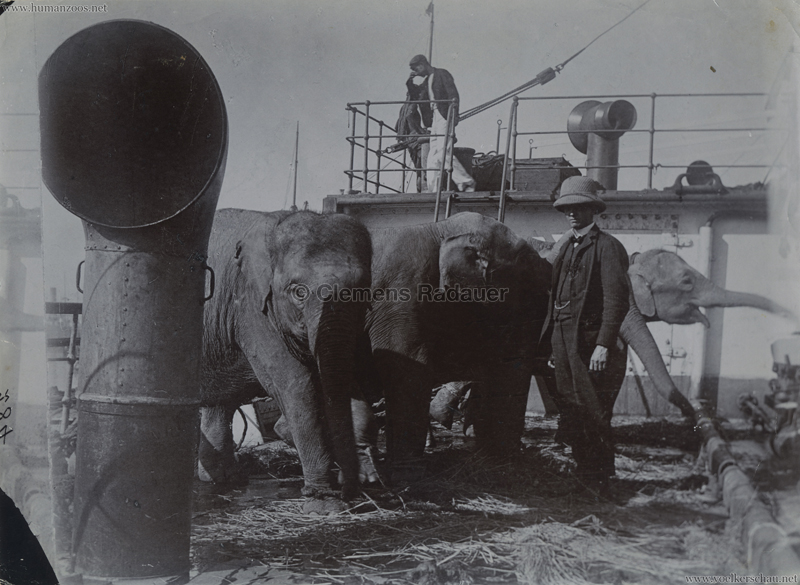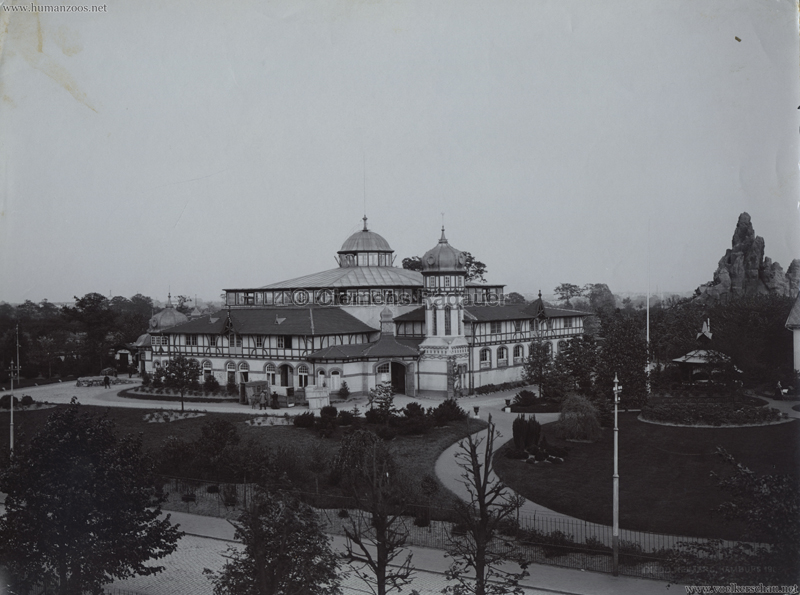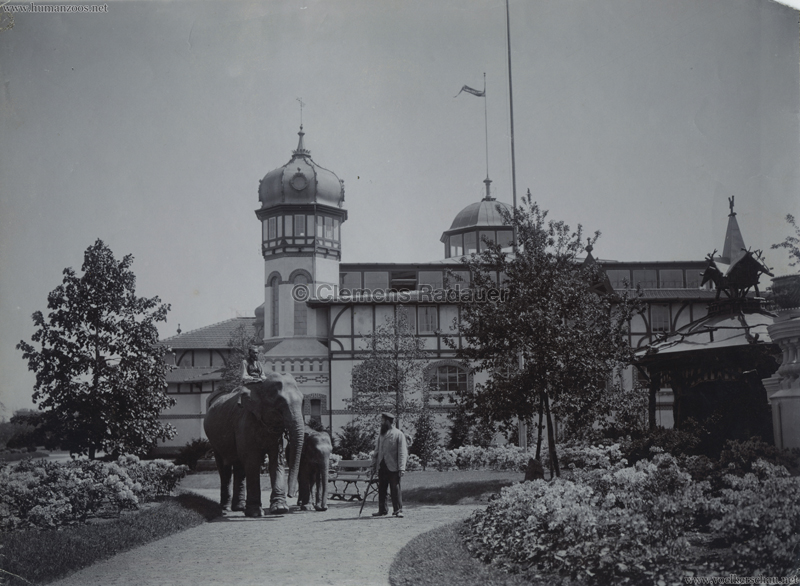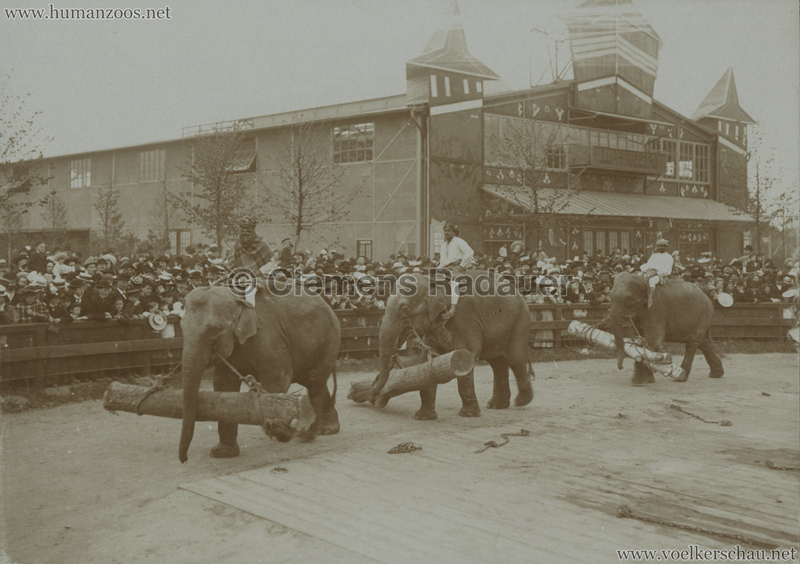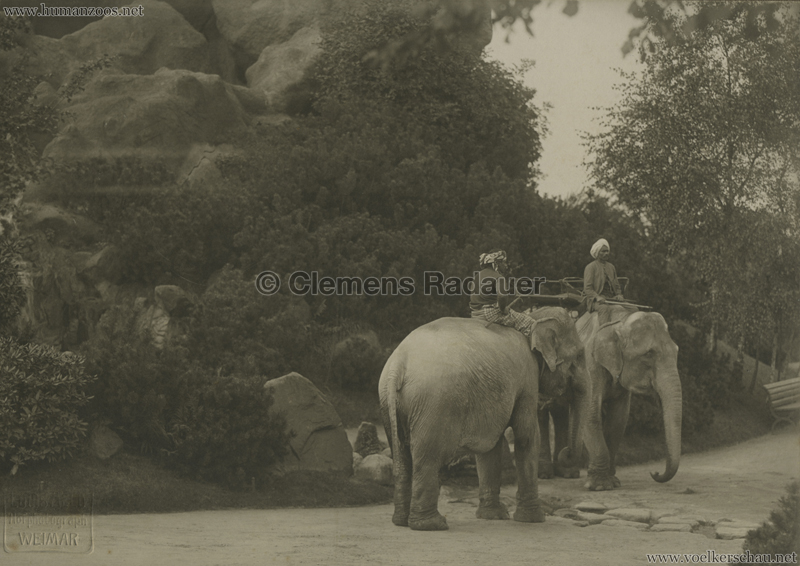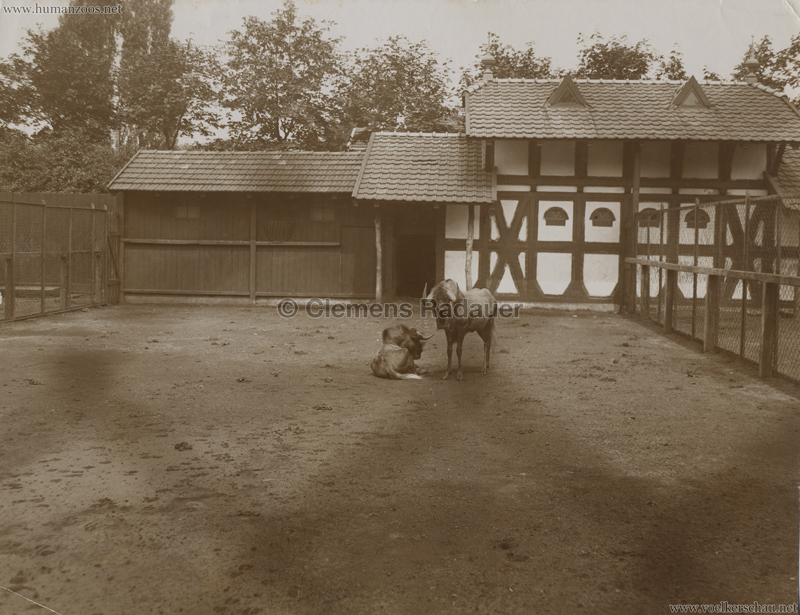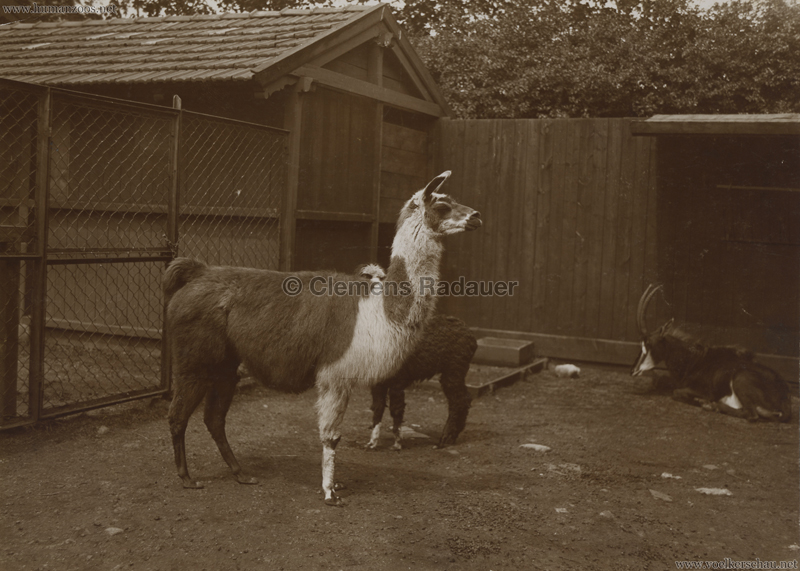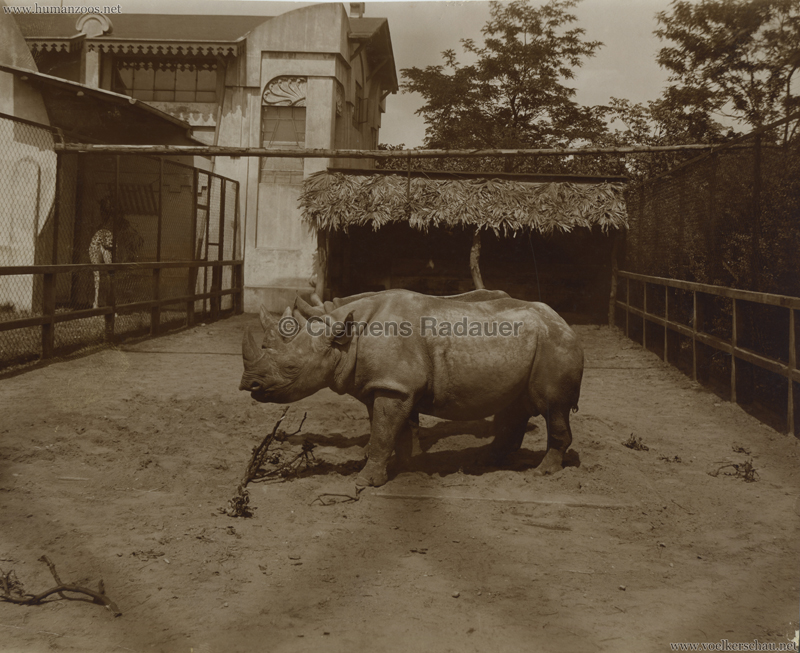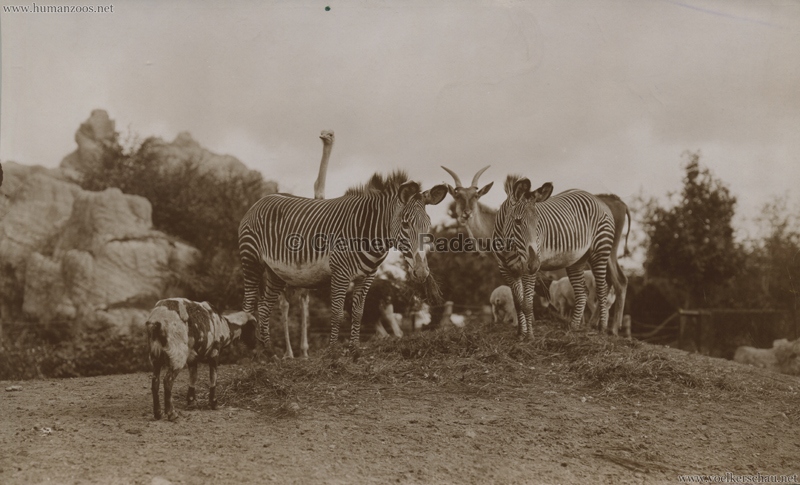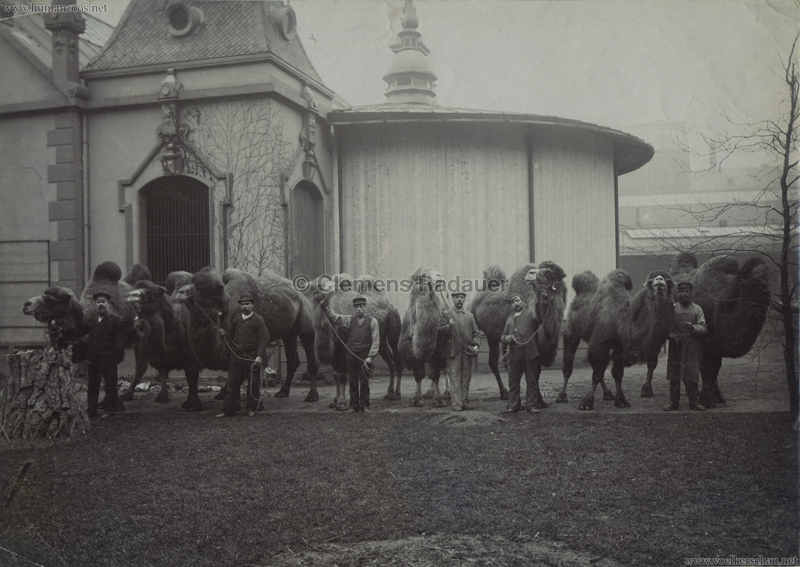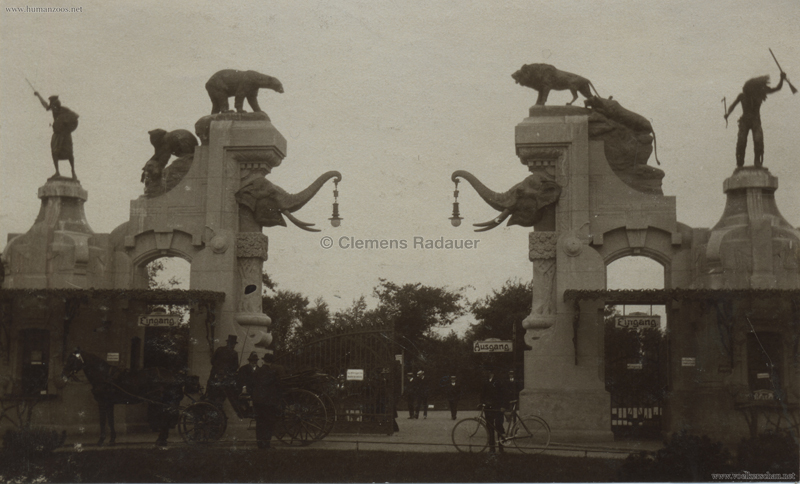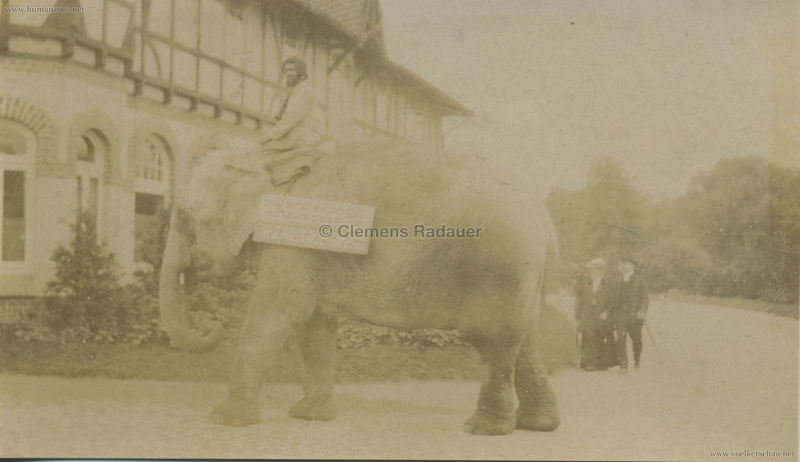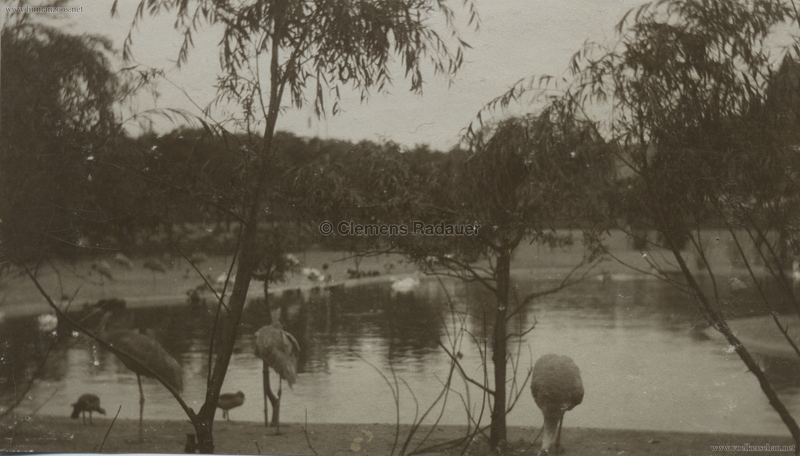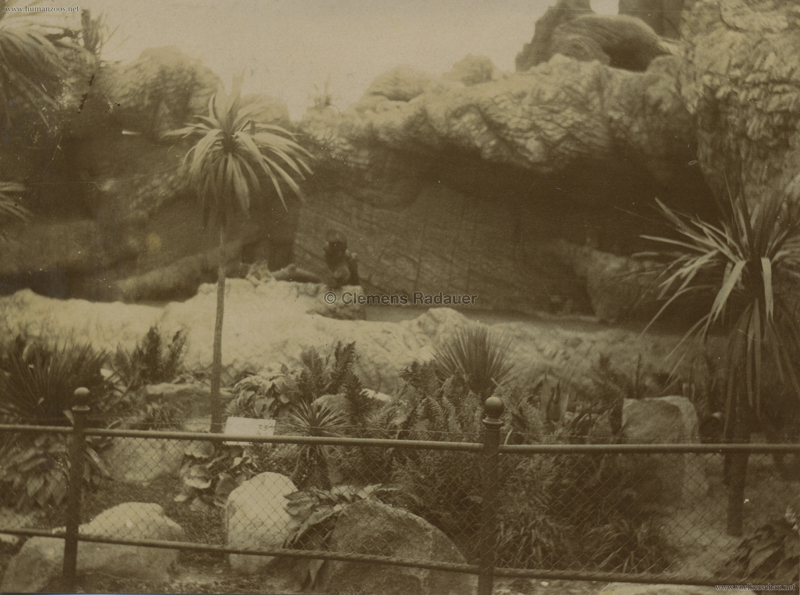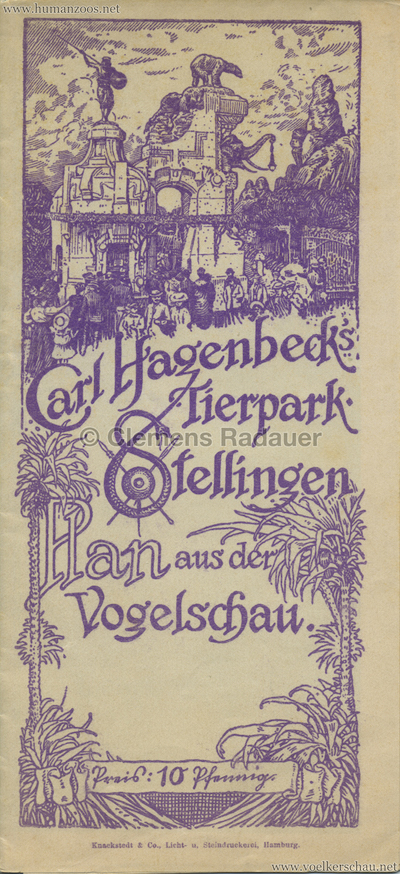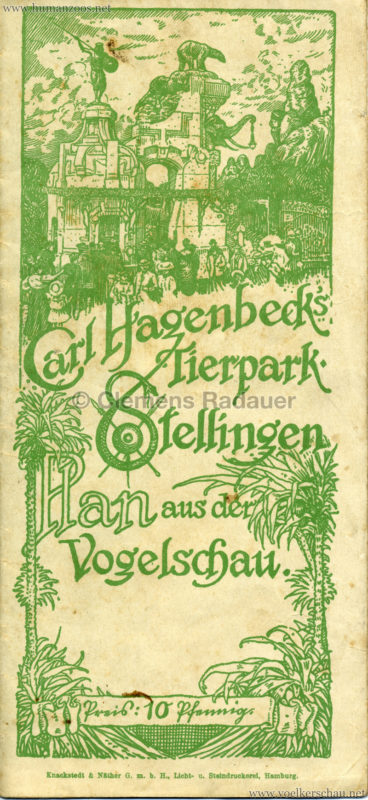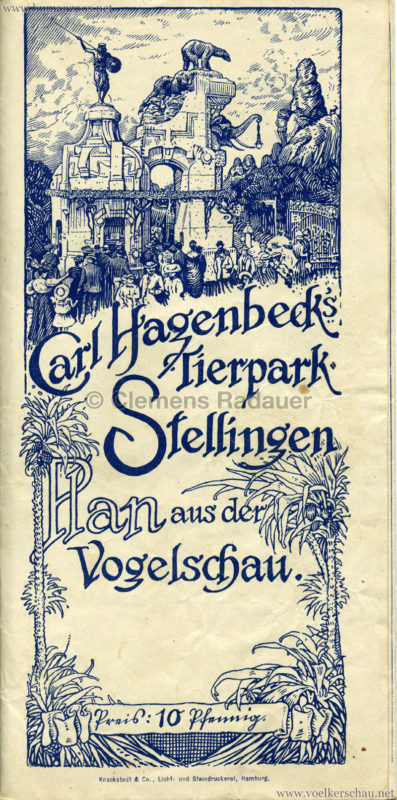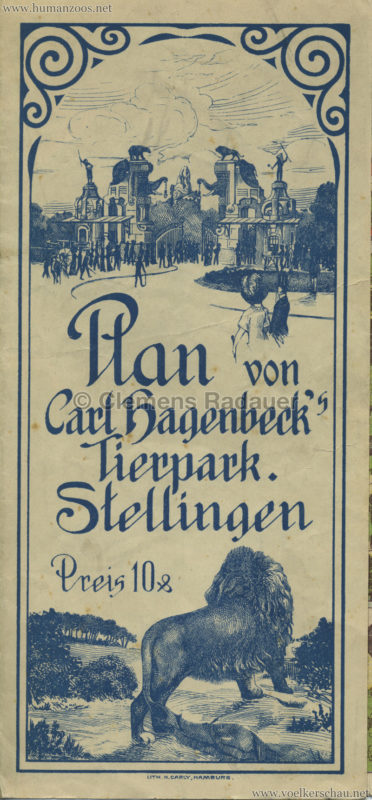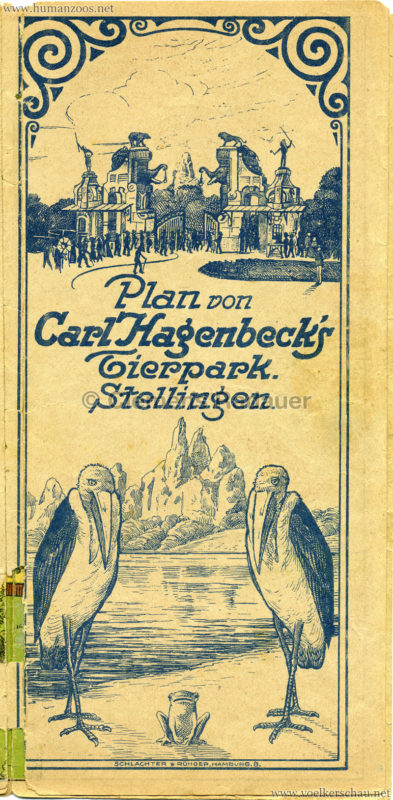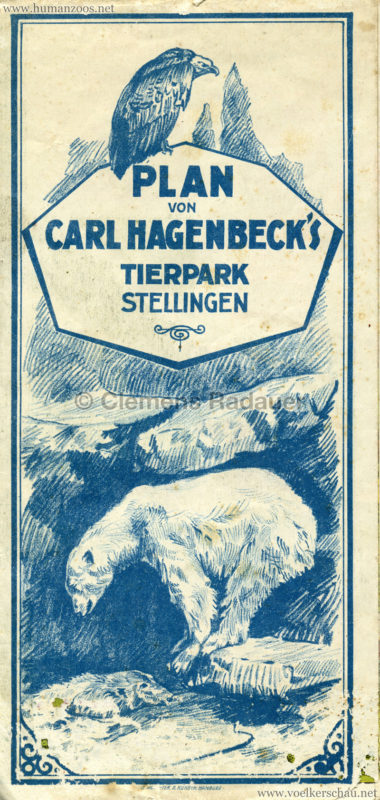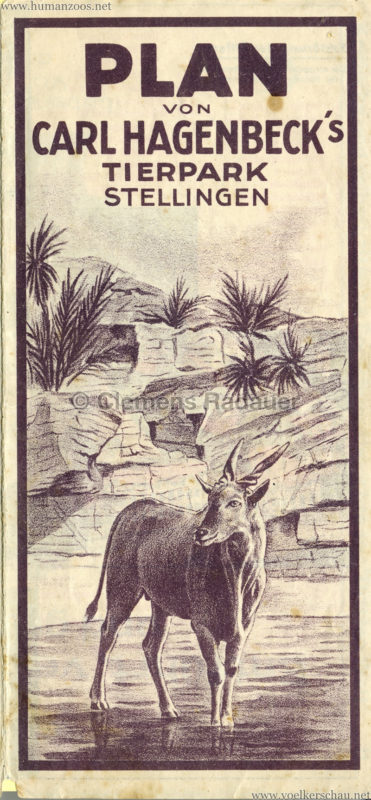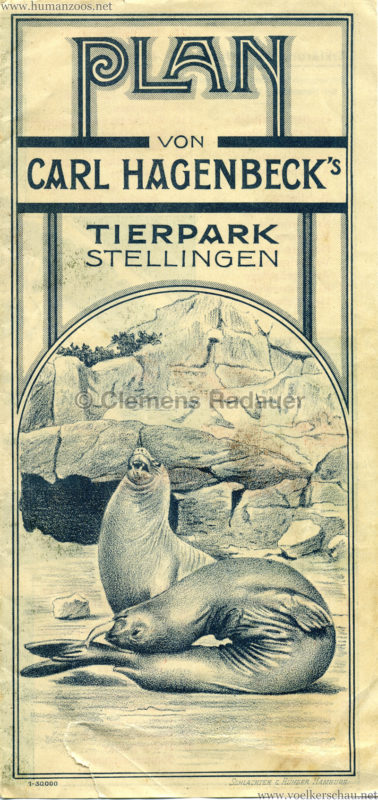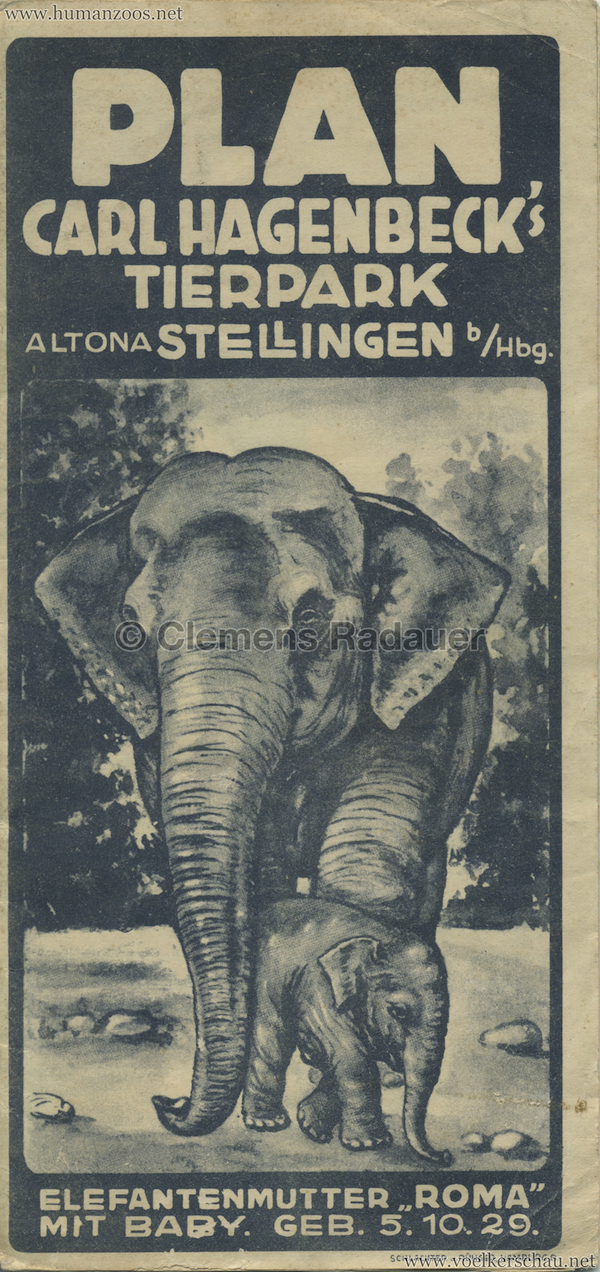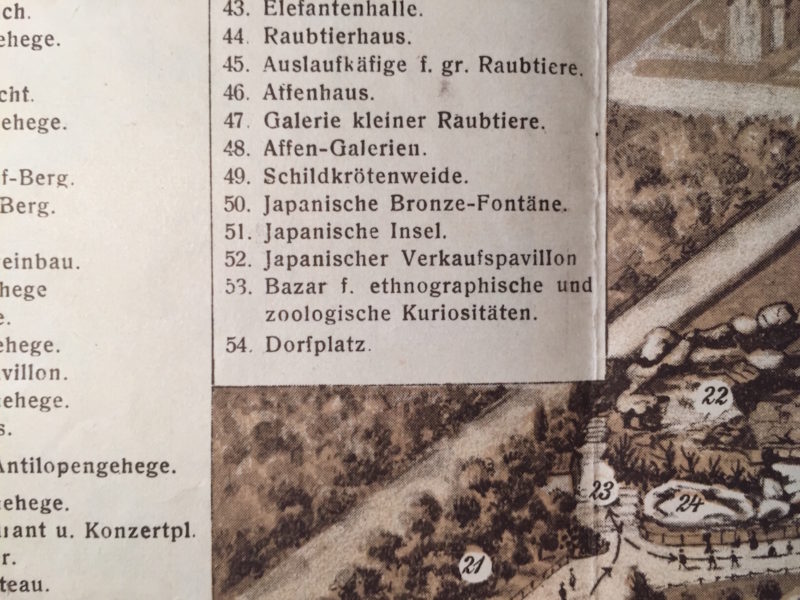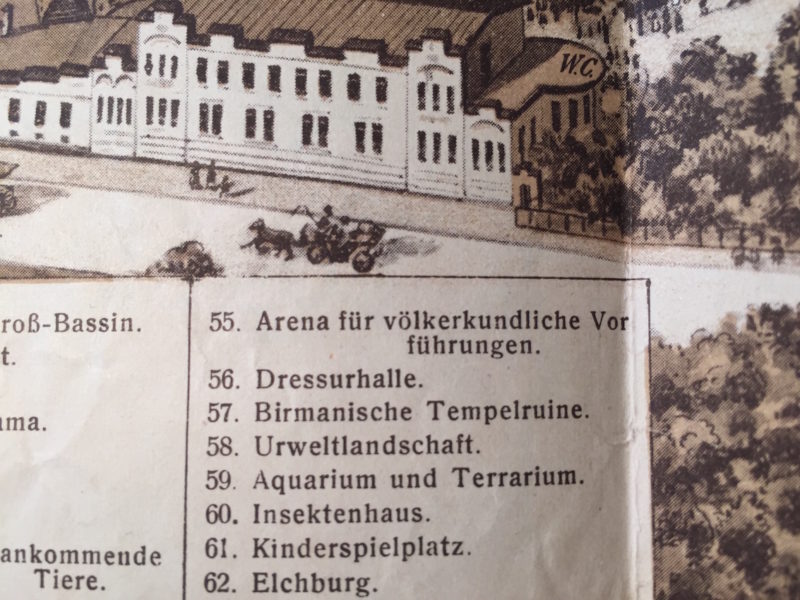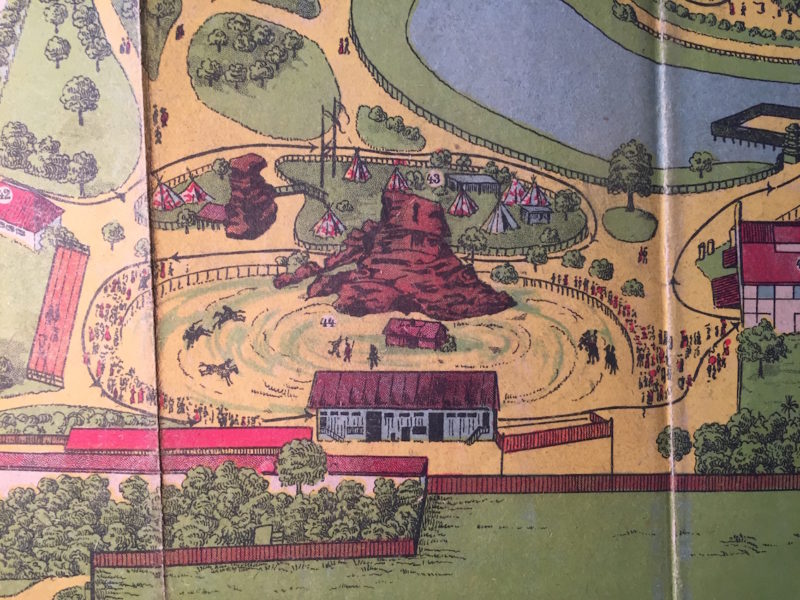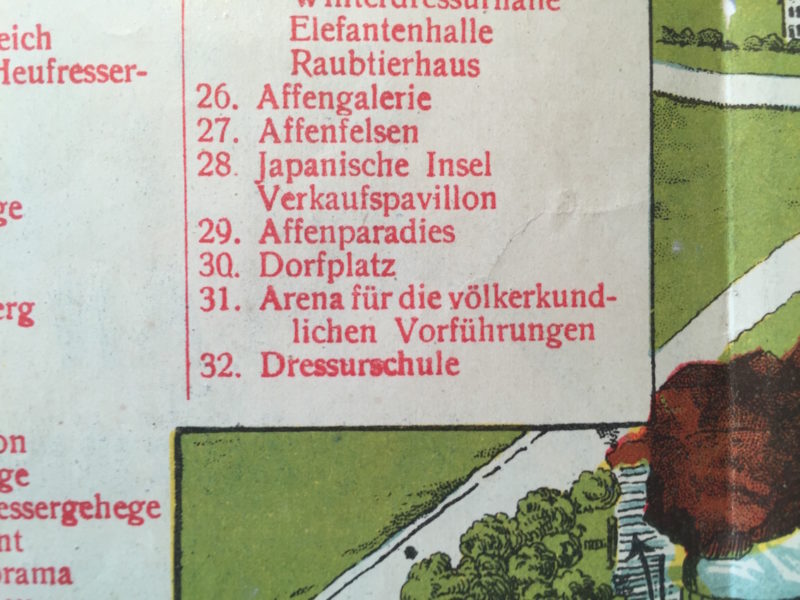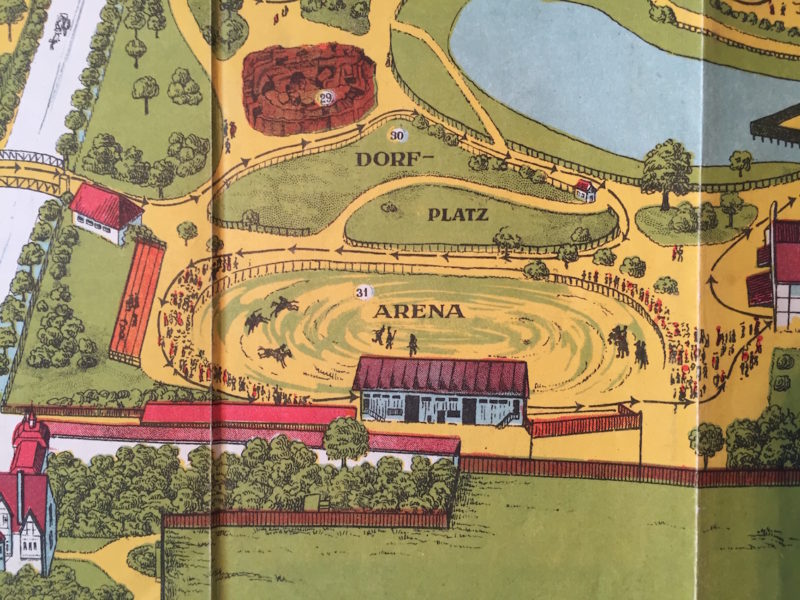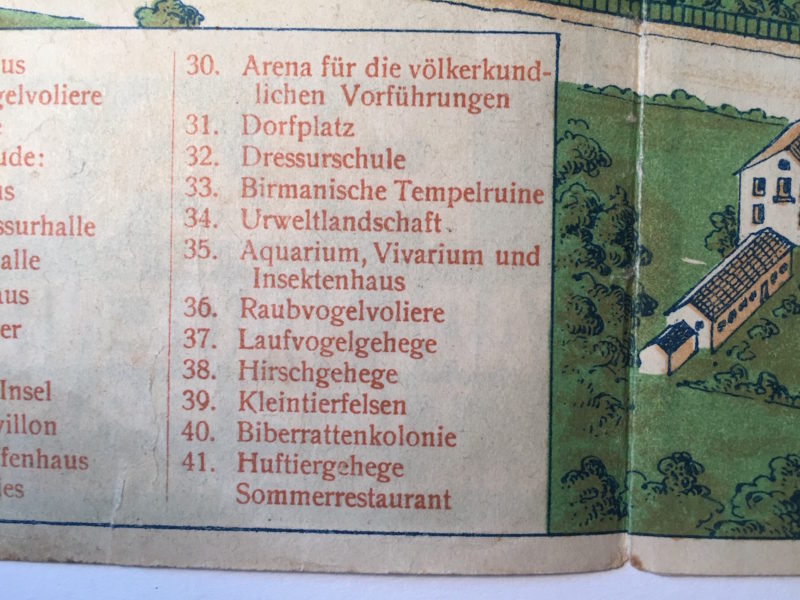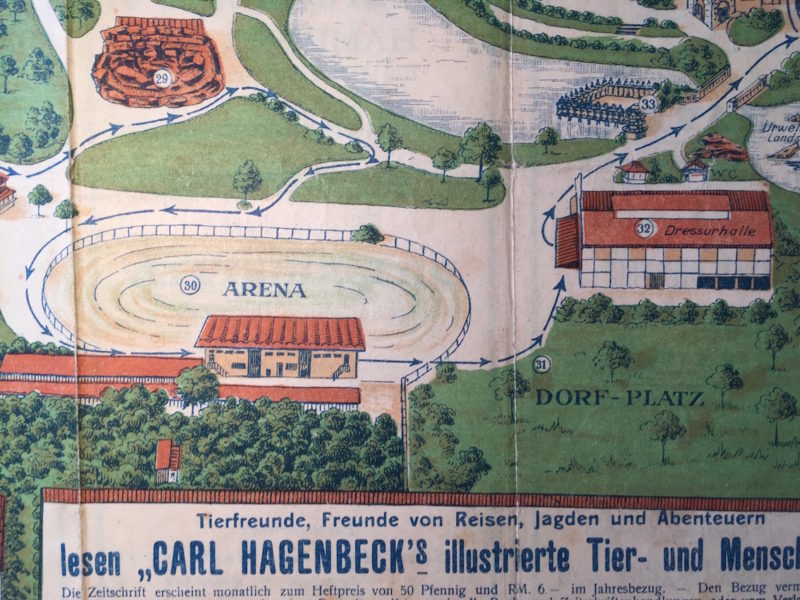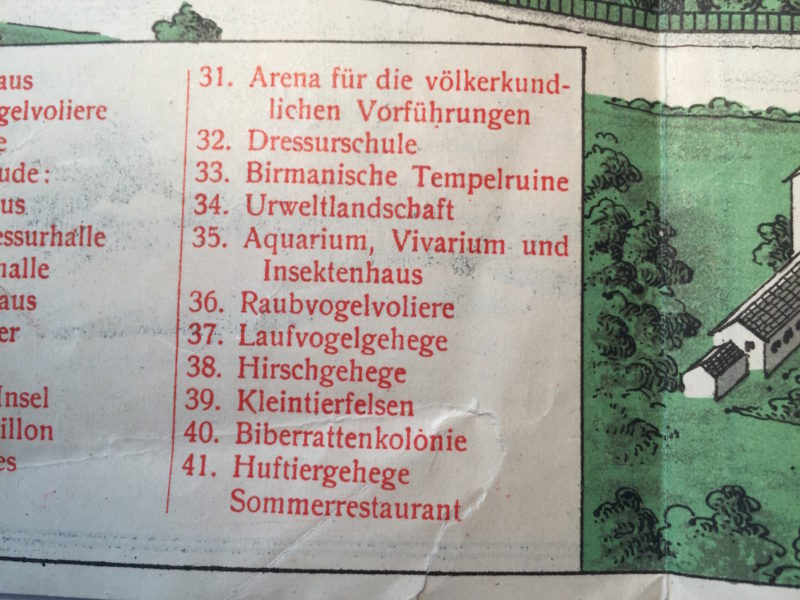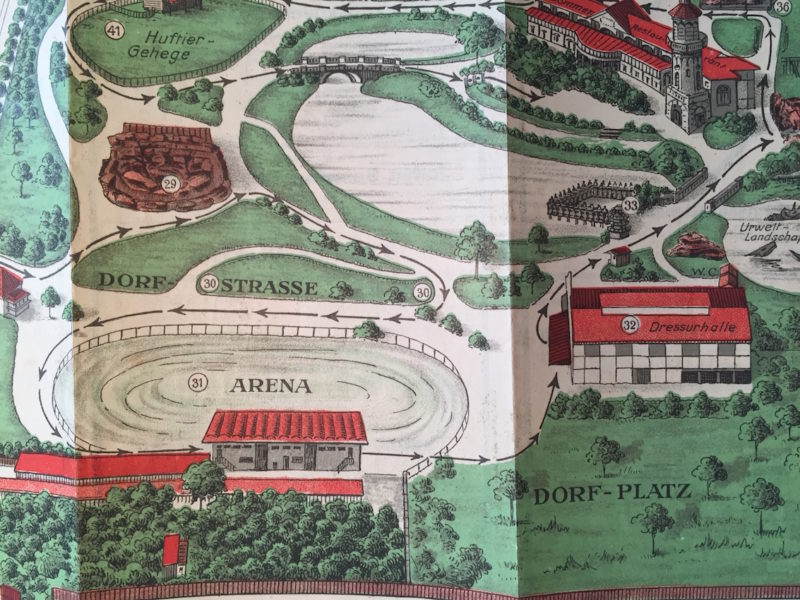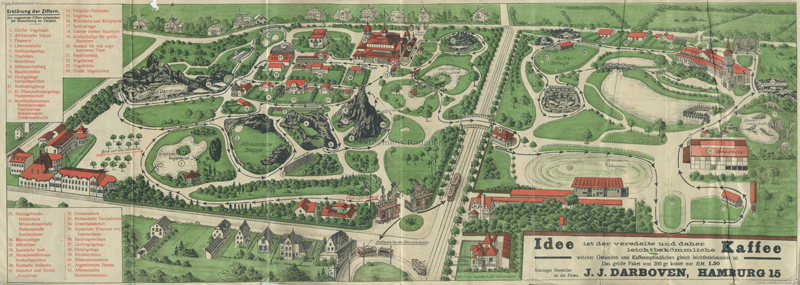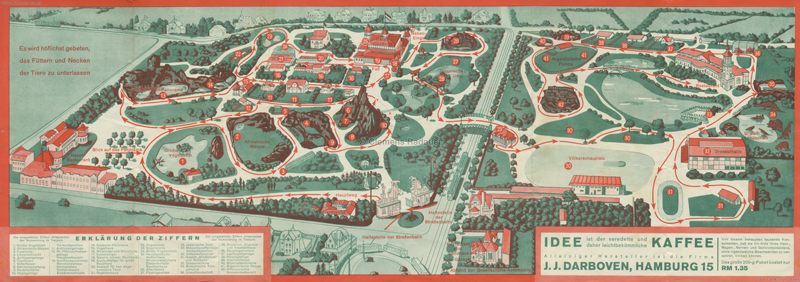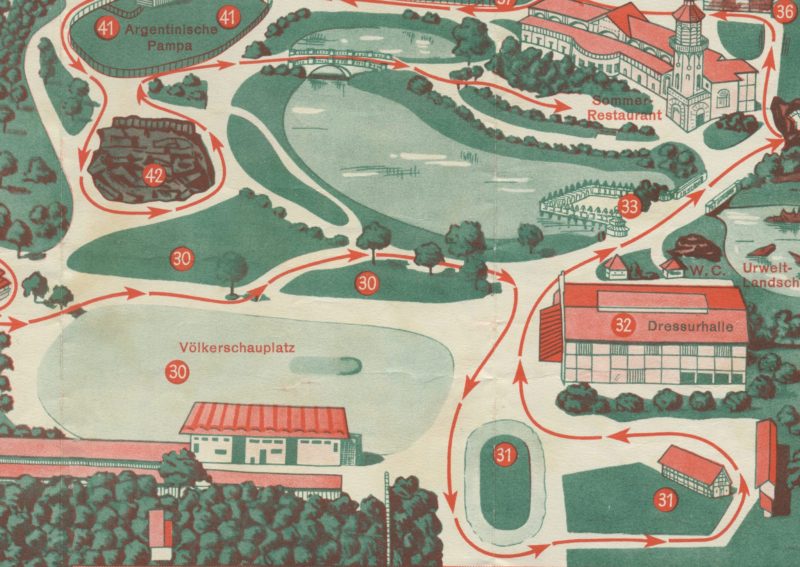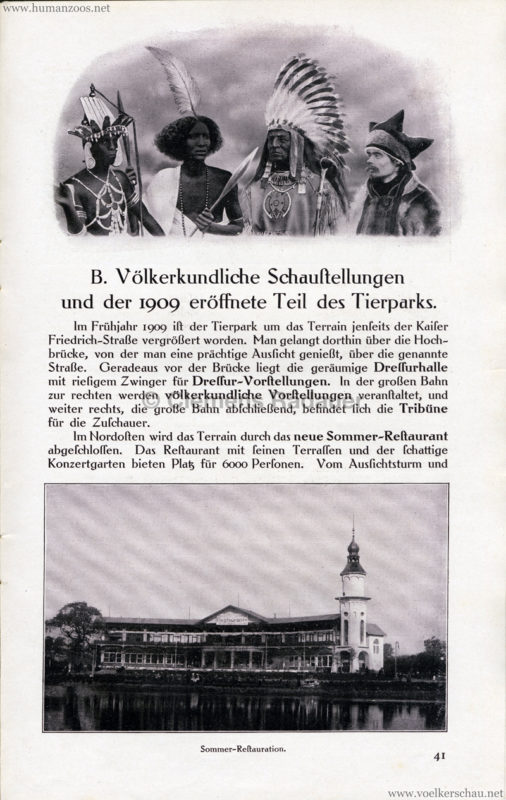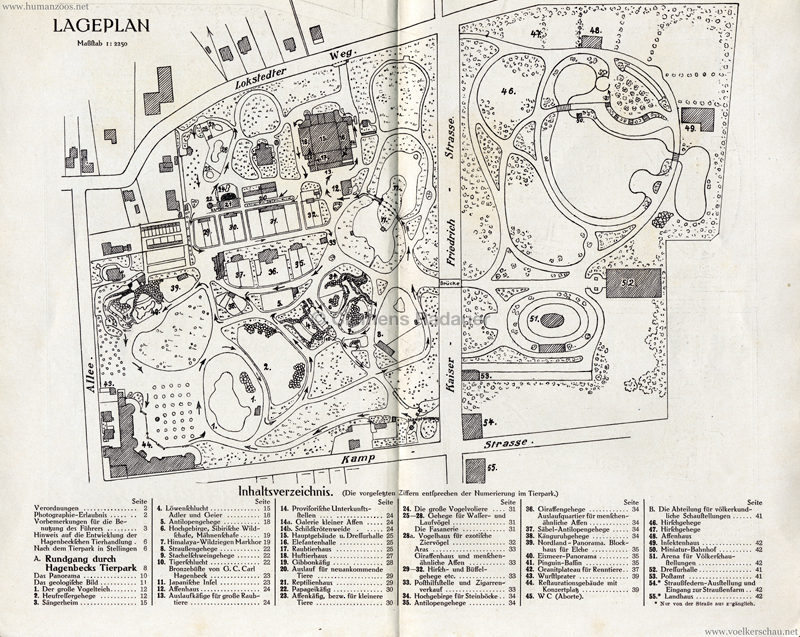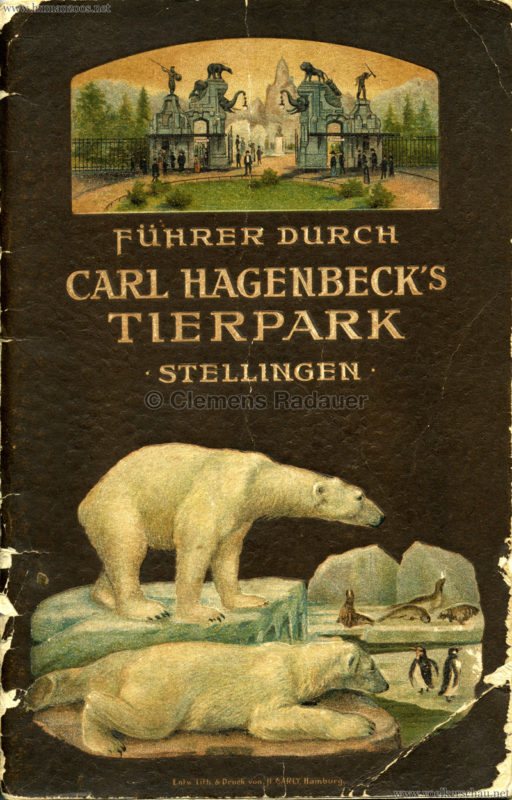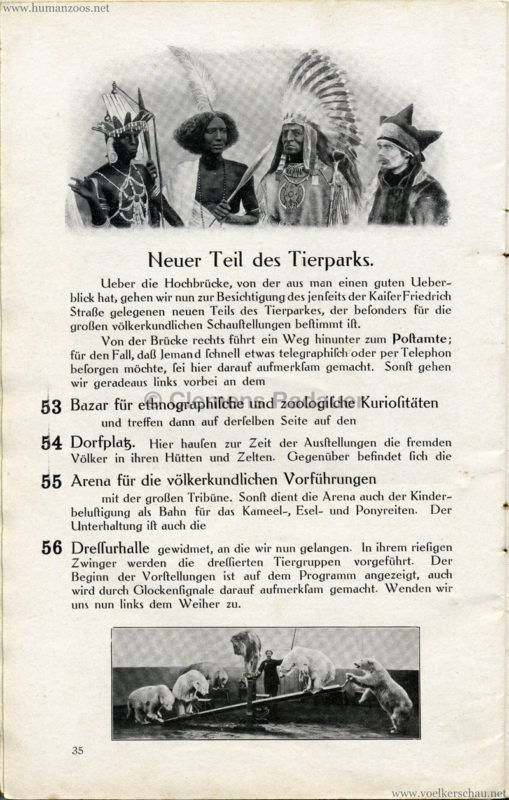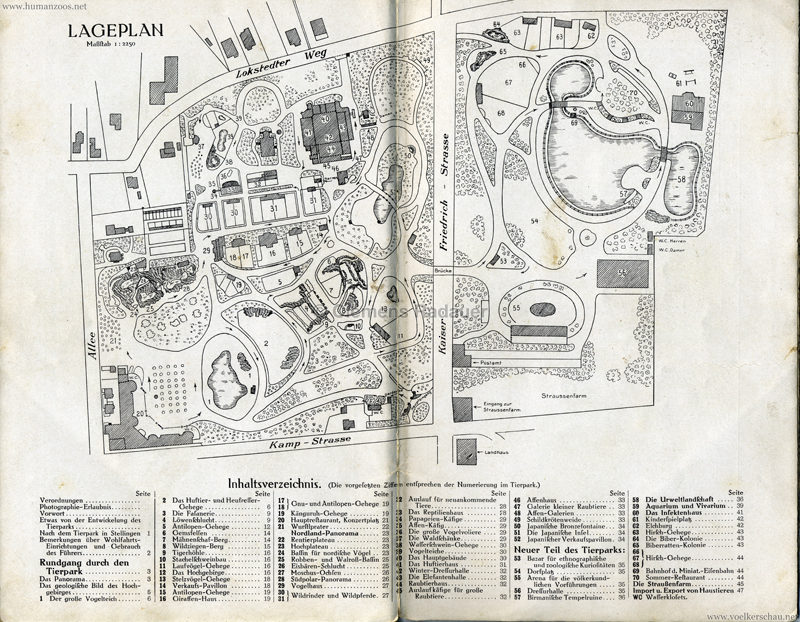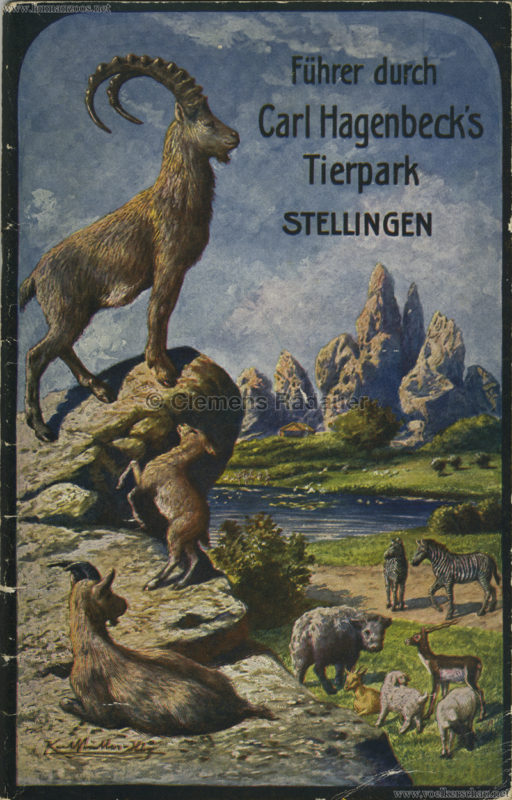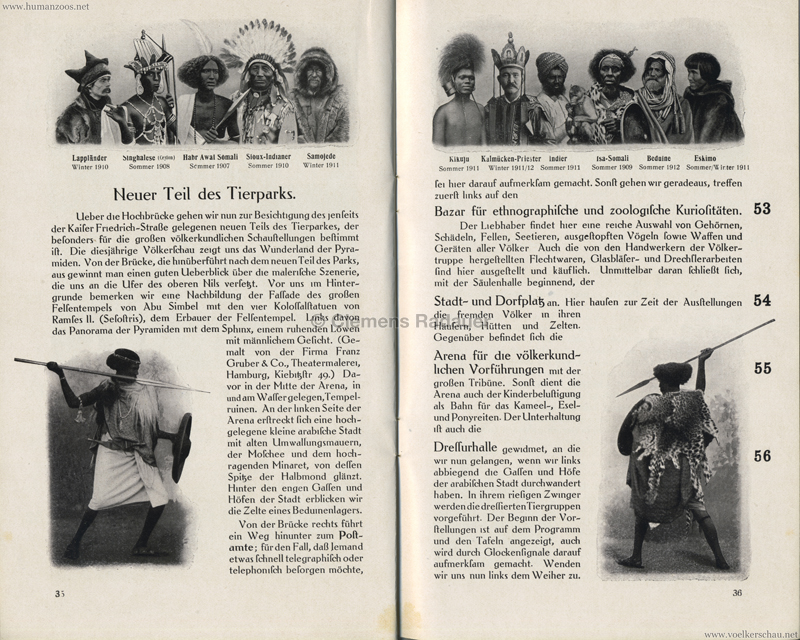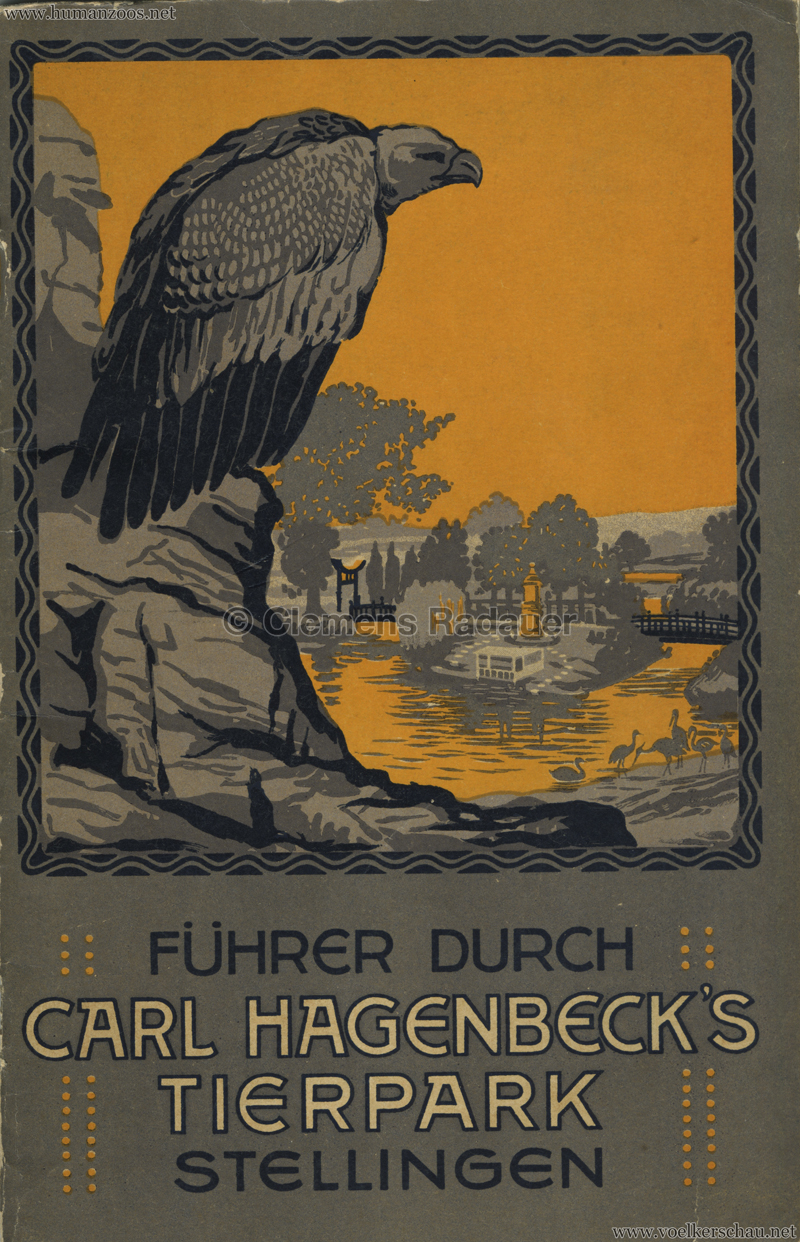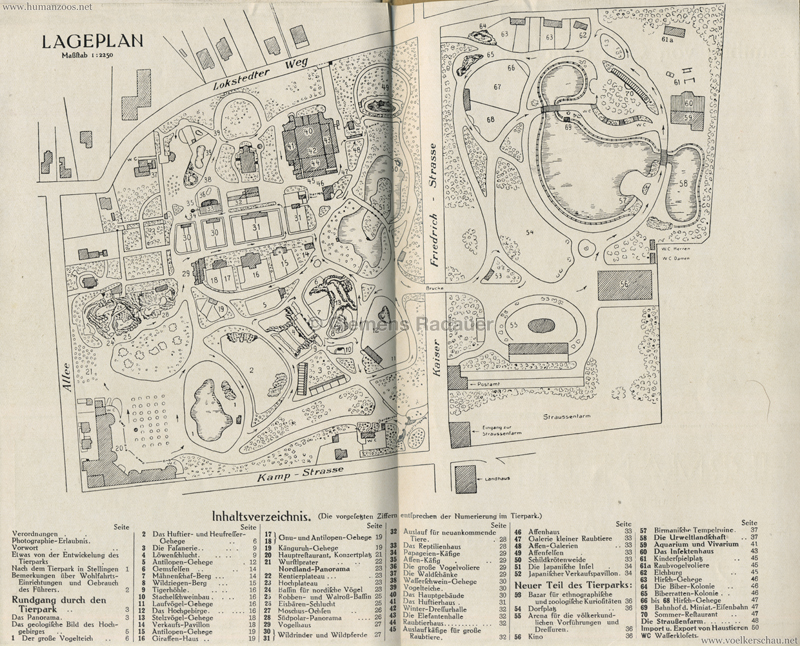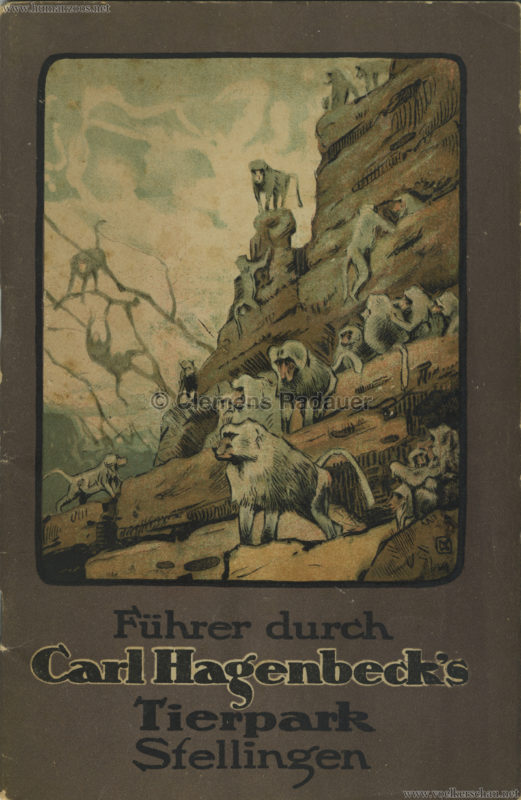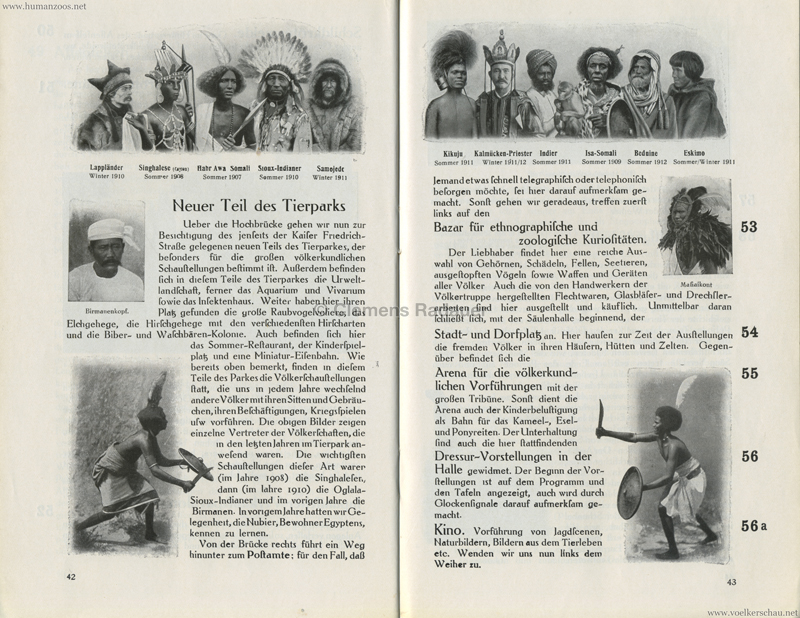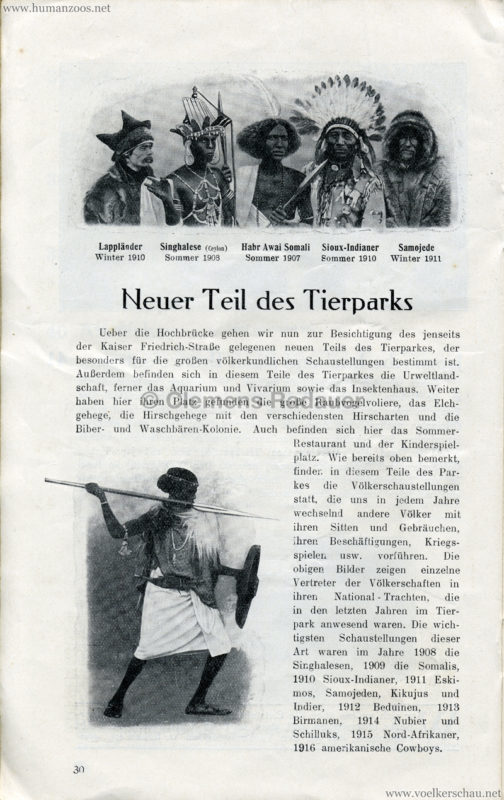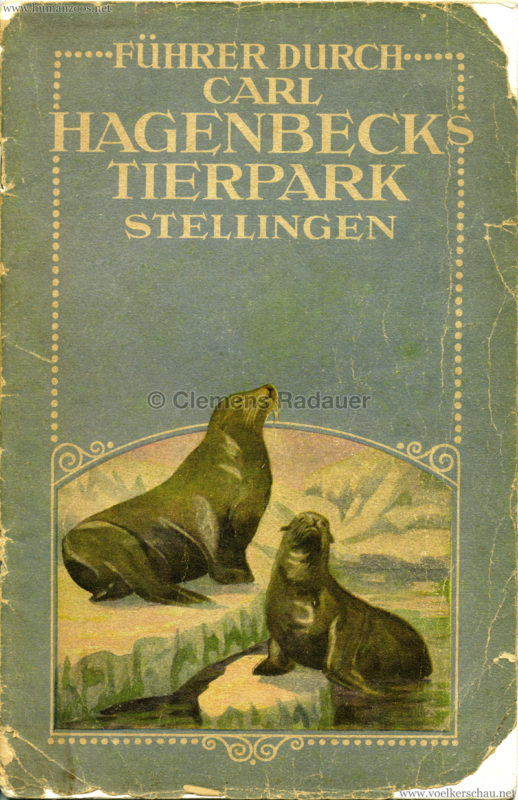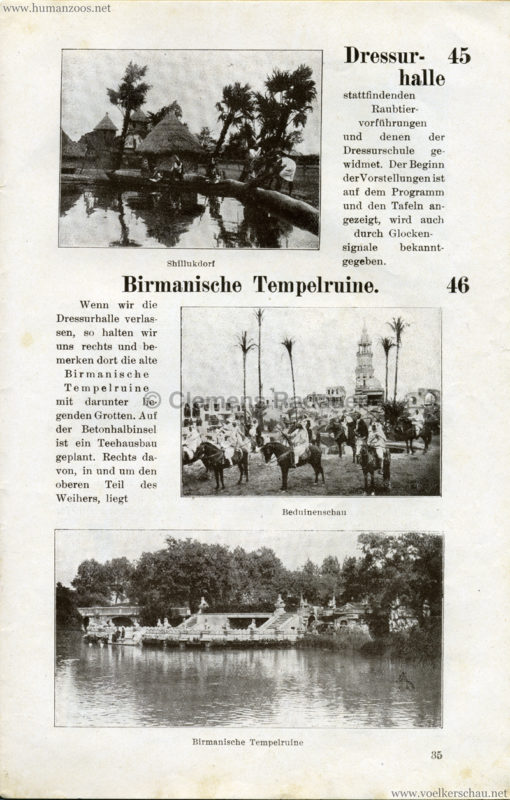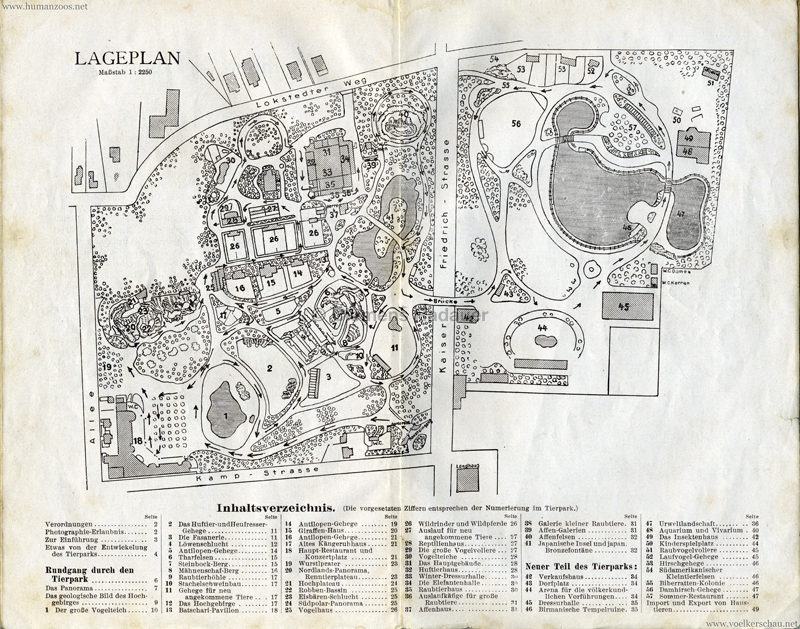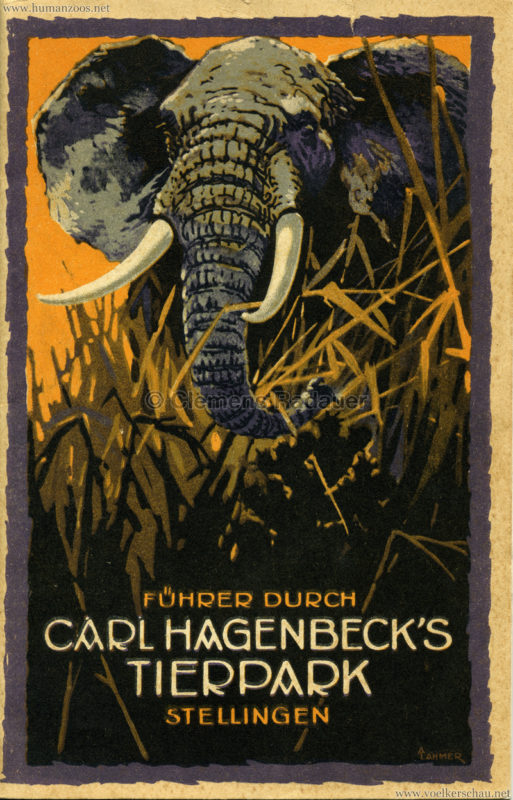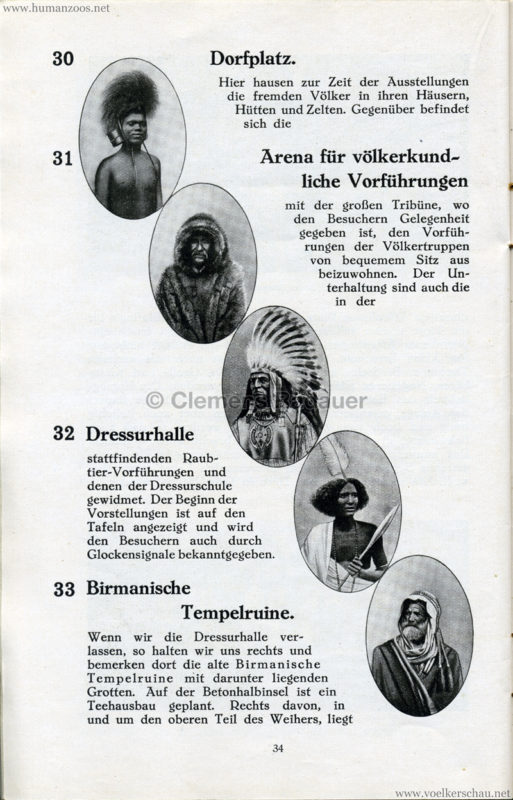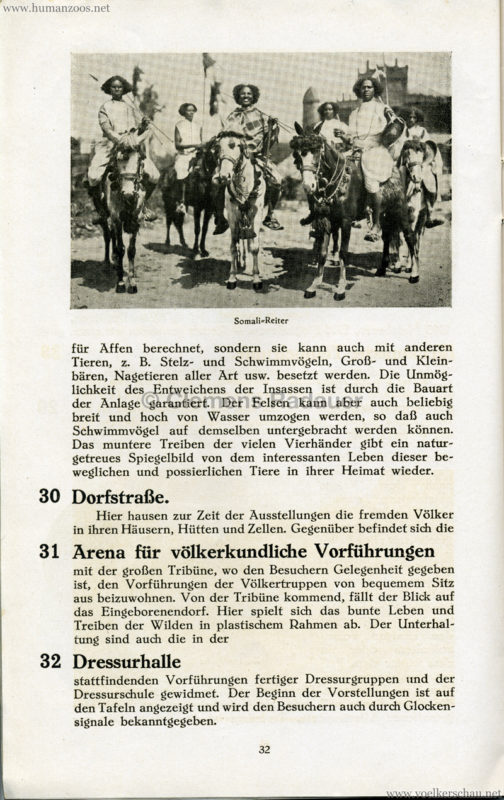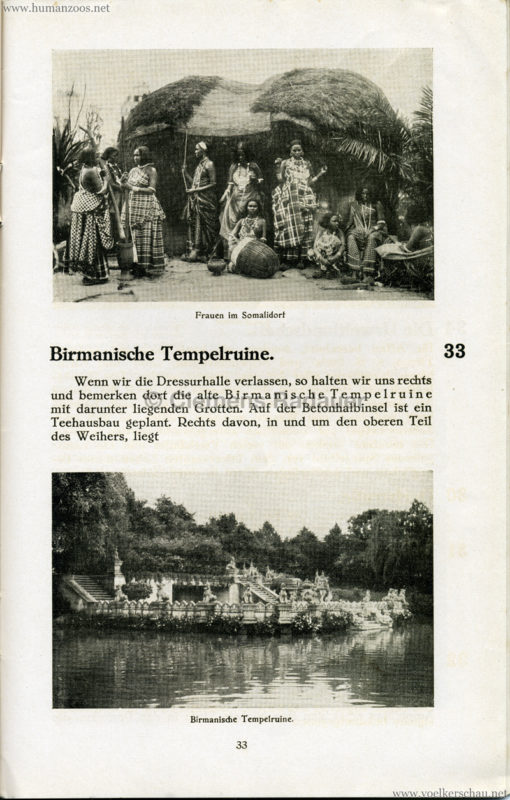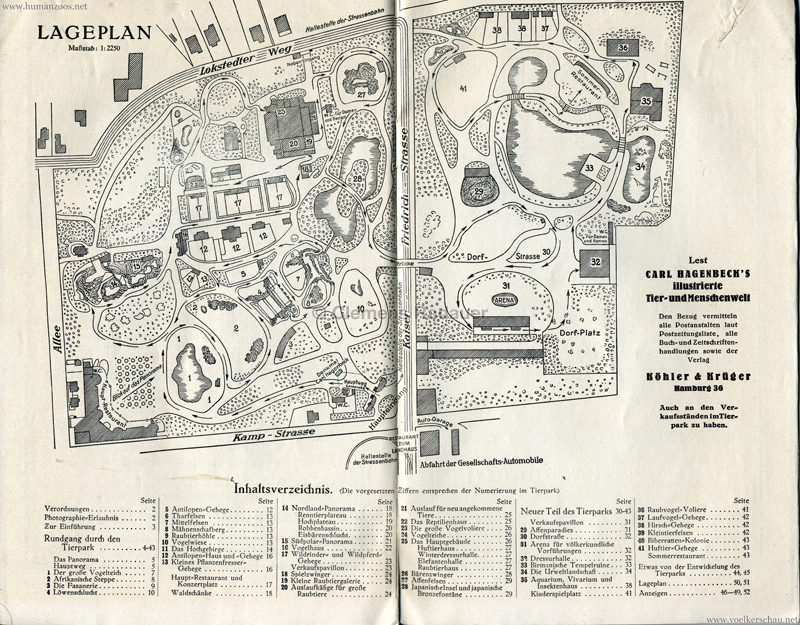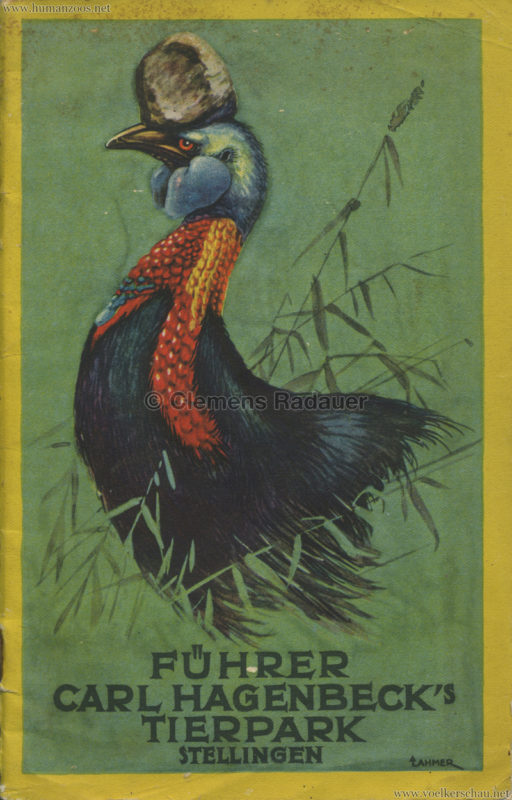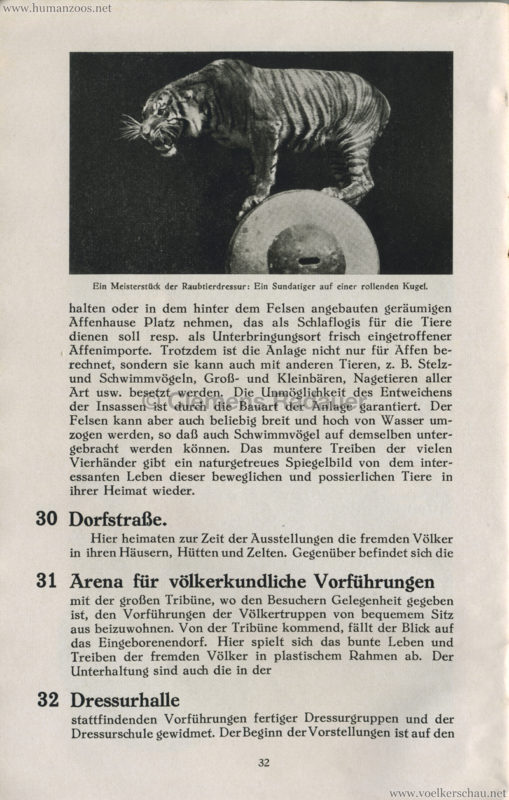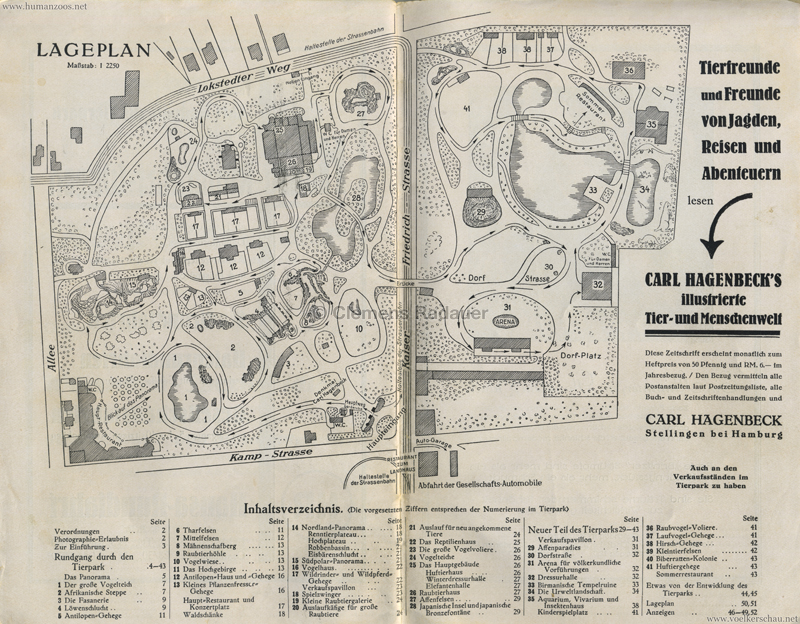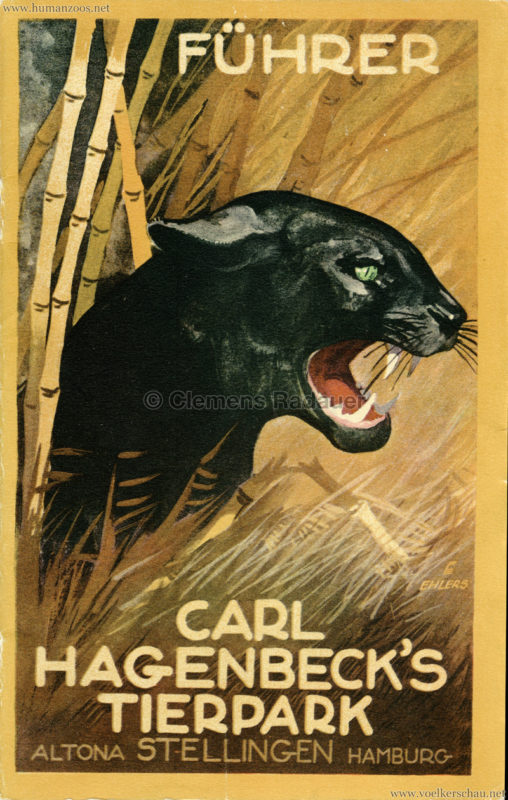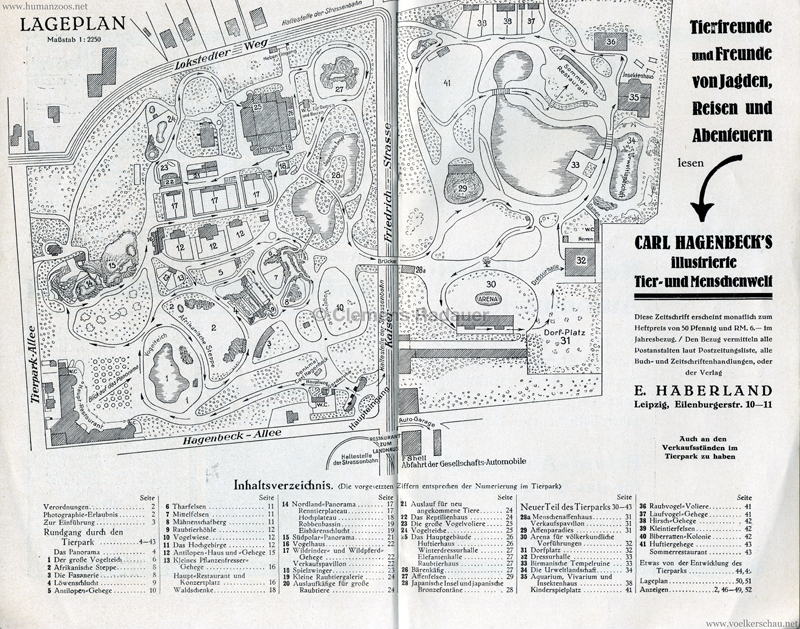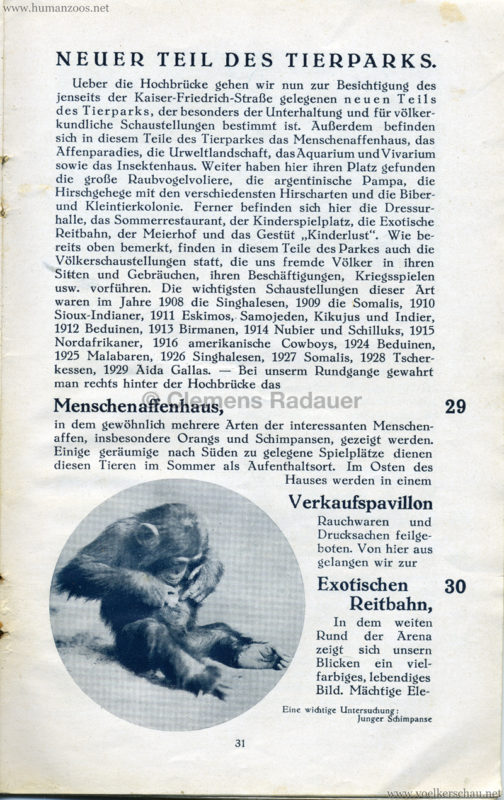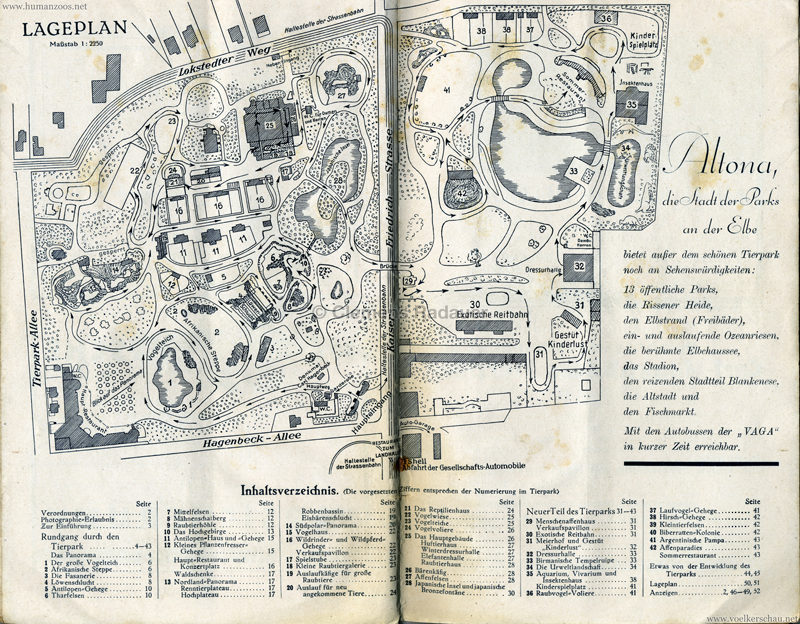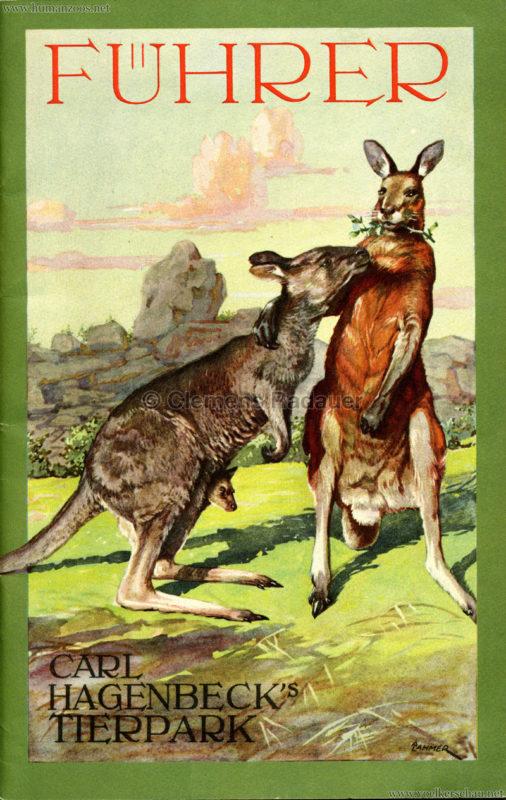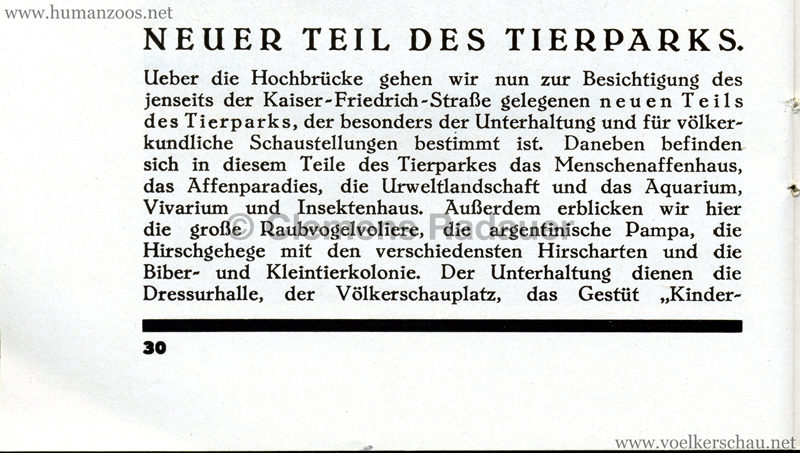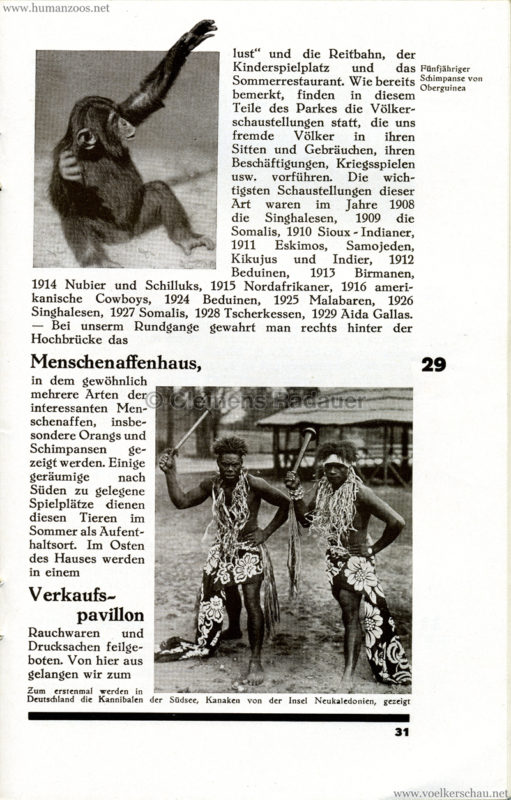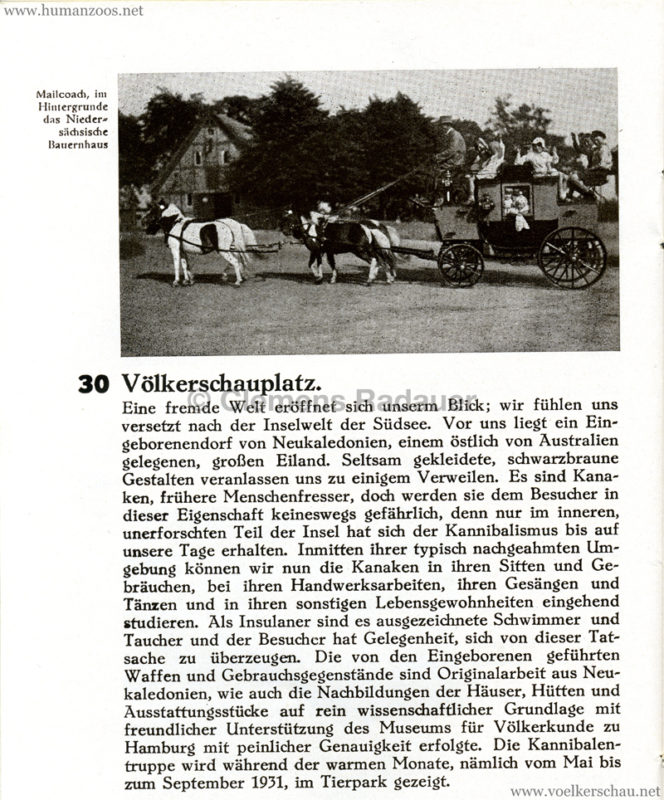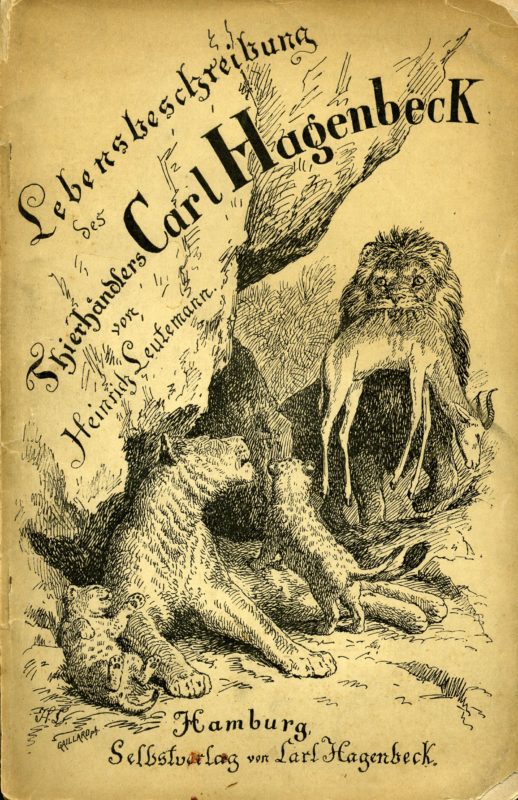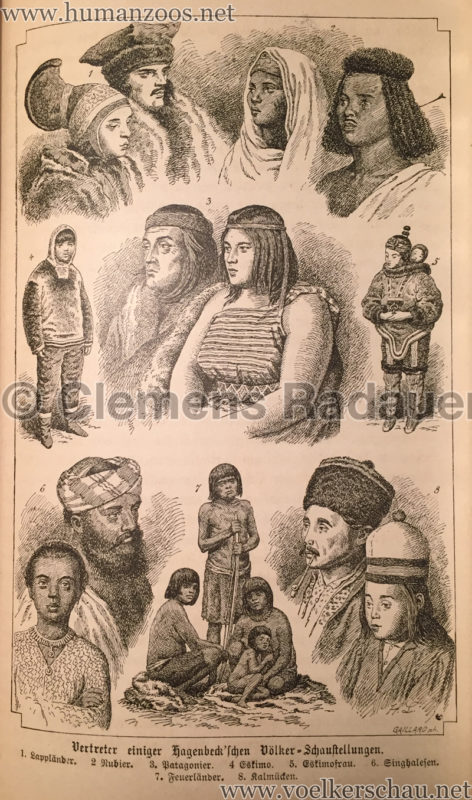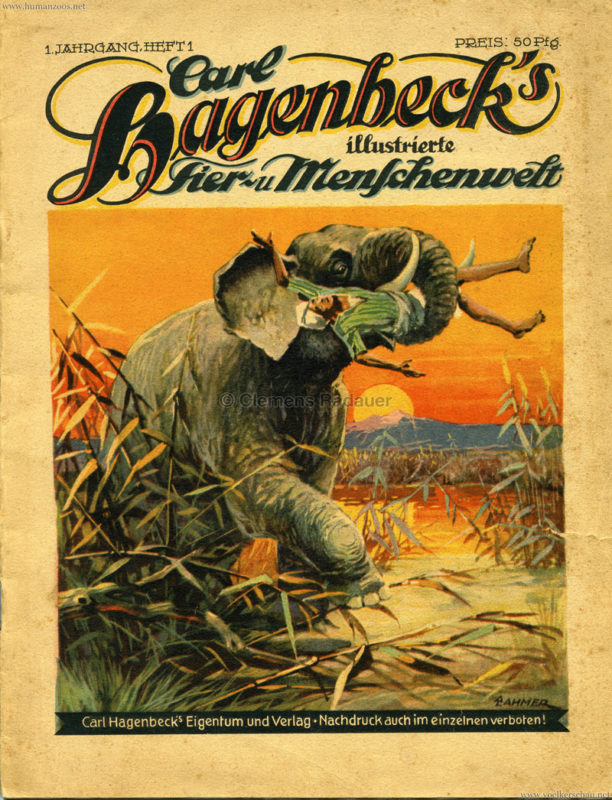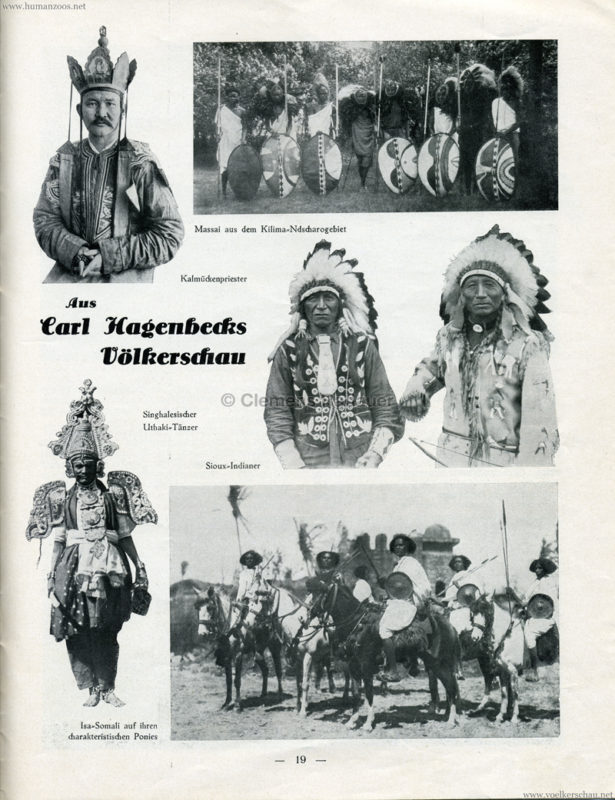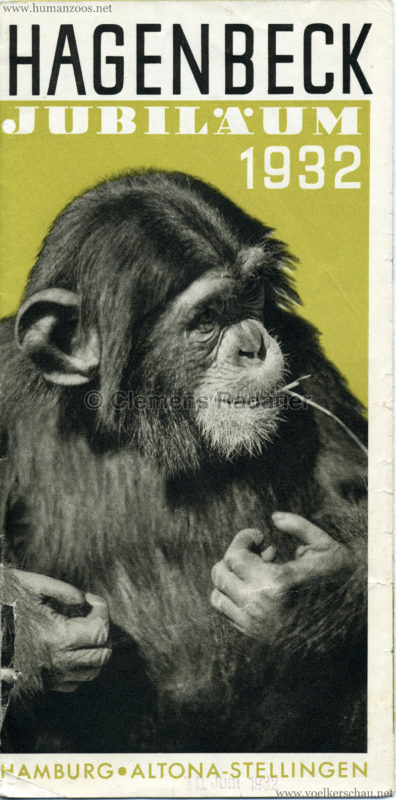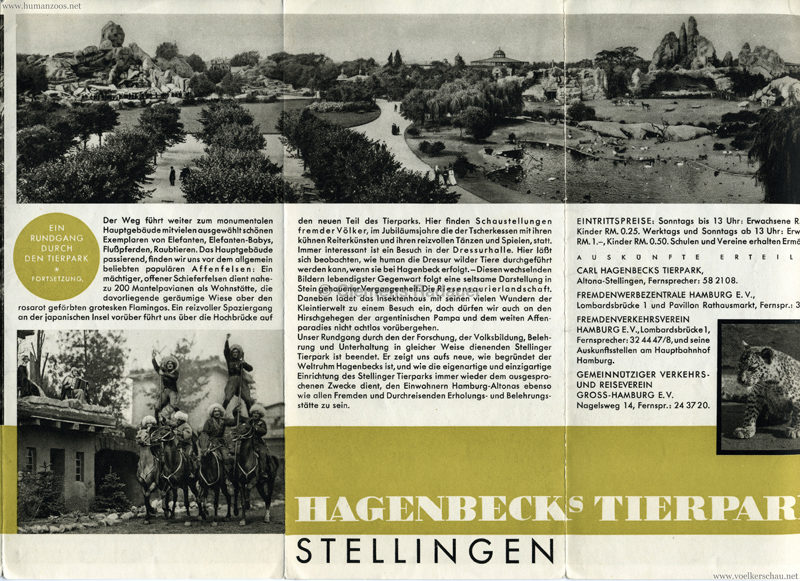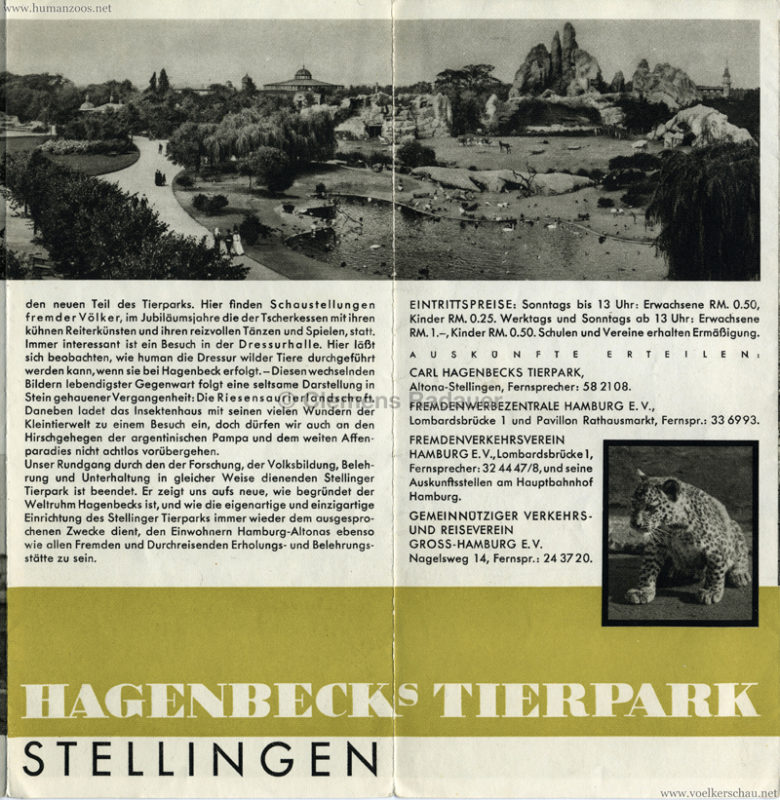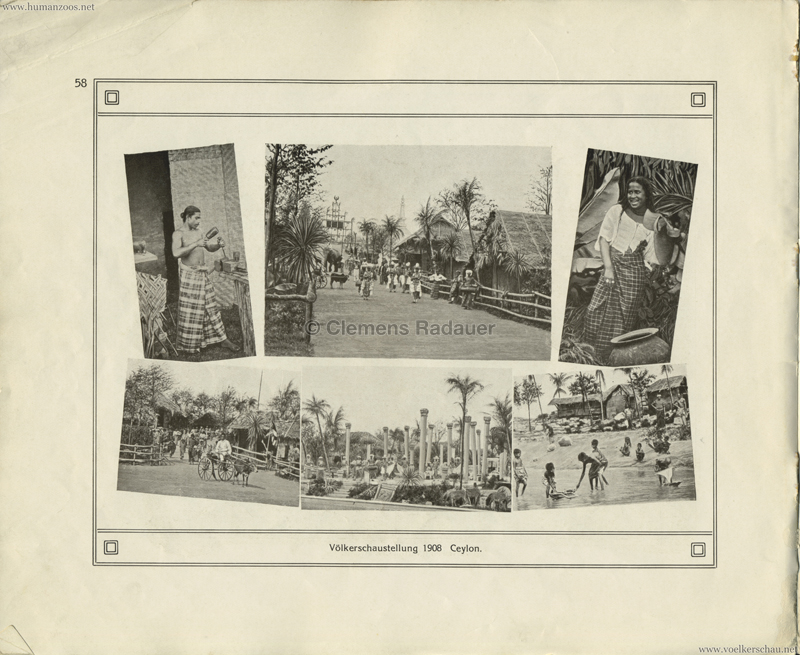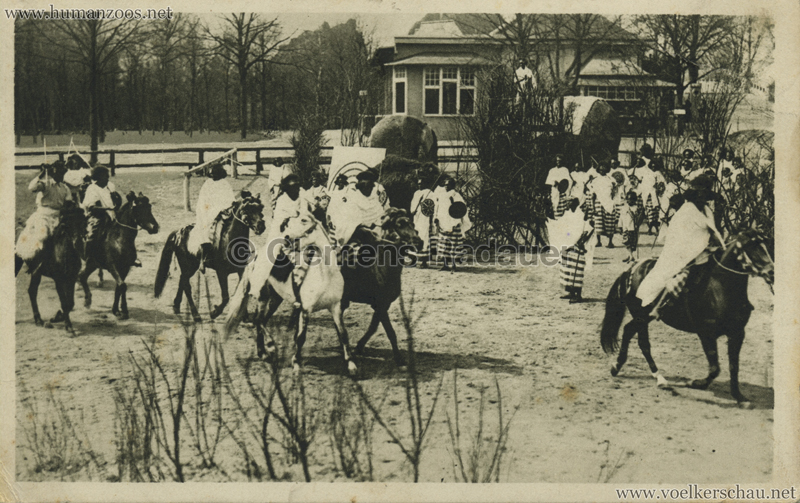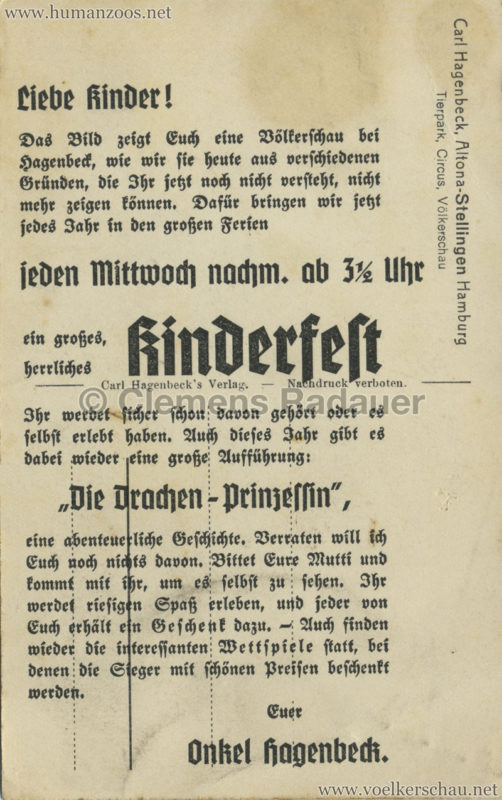On the 7th of May 1907 Carl Hagenbeck opened his new Zoo (Tiergarten) in Stellingen just outside of Hamburg. At the time it was one of the most modern zoos in the world not just because it incorporated a new standard of zoo exhibit without cages but because of the grade of presentation altogether.
Photos:
a group of fotos probably from 1907:
In 1909 the park was enlarged and the new part included an area designated to human zoos – including an arena for performances with stands for visitors and a village square where “native” villages were staged.
Maps:
These are some covers of foldout maps of the Hagenbeck Zoo:
- This early map of the Hagenbeck Zoo is from approx. 1909 – the year when Hagenbeck enlarged his zoo. The new part was situated across the street from the original zoo and was accessable by crossing a bridge:
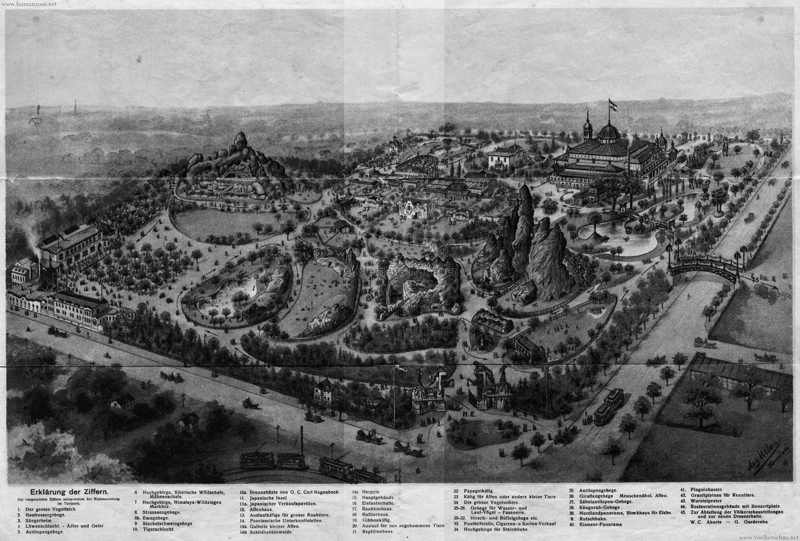
1909 (?) Carl Hagenbecks Tierpark PLAN
The new area is not yet shown on the map but is mentioned under point 45: Zur Abteilung der Völkerschaustellungen und zur neuen Dressurhalle which roughly translates to “To the human zoo area and to the new dressage hall”.
- Later maps – like this one from around 1910 – show the new part of the Hagenbeck Zoo including the area for the exhibition of human zoos. It consisted of a bazar for ethnographical and zoological curiosities/Bazar für ethnographische und zoologische Kuriositäten (53.), a village square/Dorfplatz (54.) and an arena for ethnographical shows/Arena für völkerkundliche Vorführungen (55.). The arena included a big artificial rock that was used for human zoos as setting for the performances and photographies. This depiction of the human zoo area is in a wild-west style (tipis, stagecoach, horseriders, etc.) which is most likely a reference to the human zoo Sioux Indianer of 1910:
- The layout of this map dating from after 1910 is very similar to the one above. The area designated to human zoos is still depicted in a wild-west style. The village square/Dorfplatz (43.) and the arena for ethnographical shows/Arena für völkerkundliche Vorführungen (44.) have not changed yet the bazar for ethnographical and zoological curiosities seems to have been canceled:

1912 (?) Carl Hagenbecks Tierpark PLAN
- This map from about 1915 shows that the appearance of the human zoo arena had changed: the big artificial rock had been removed. The arena was also no longer depicted in a wild-west style. The village square/Dorfplatz (30.) and the arena for ethnographical shows/Arena für völkerkundliche Vorführungen (31.) continue to be listed:

1915 (?) Carl Hagenbeck Tierpark PLAN
- Until 1926 the location of the village square/Dorfplatz (31.) was moved to the opposite side of the arena for ethnographical shows/Arena für völkerkundliche Vorführungen (30.):

1926 Carl Hagenbeck Tierpark PLAN
- In this map of 1927 a new addition to the human zoo area is listed: village street/Dorfstraße (30.) right above of the arena for ethnographical shows/Arena für völkerkundliche Vorführungen (31.). The village square/Dorfplatz is still indicated but not llisted:

1927 Carl Hagenbeck Tierpark PLAN
- This map from the 1920ies is identical to the one from 1927:
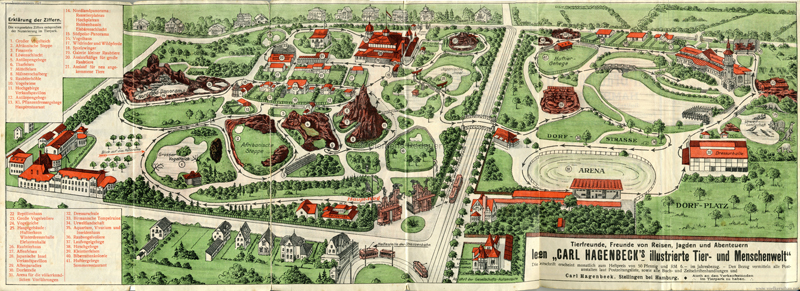
- In this map from 1930 the human zoo arena is listed under a new name: exotic racetrack/Exotische Reitbahn (30.) and the village street/Dorfstraße is neither listed nor indicated.
- In this map from the 1930ies the human zoo arena is listed under a new name: humanzoo place/Völkerschauplatz (30.) and the village street/Dorfstraße is neither listed nor indicated.
Booklets:
These booklets of approximately 50 pages where sold at Hagenbecks Tierpark and include information about all attractions of the zoo and a map. Since every edition was updated they are a great source of information on the development of Hagenbecks Zoo.
- This 4th edition booklet (150.000 – 200.000) was published in 1909. The area for human zoos is only mentioned in the section about the new part of the zoo and features unlabeled photos of four men from human zoos – one from the Indian subcontinent, one from East Africa, one from North America (maybe Sioux) and a Sami:
- This 5th edition booklet (200.000 – 275.000) was published in 1911. It features the bazar for ethnographical and zoological curiosities/Bazar für ethnographische und zoologische Kuriositäten (53.), a village square/Dorfplatz (54.) and an arena for ethnographical shows/Arena für völkerkundliche Vorführungen (55.) and the same unlabeled photos of four men from human zoos is used as in the booklet from 1909:
- This 6th edition booklet (275.000 – 335.000) was published in 1912. It features the bazar for ethnographical and zoological curiosities/Bazar für ethnographische und zoologische Kuriositäten (53.), a village square/Dorfplatz (54.) and an arena for ethnographical shows/Arena für völkerkundliche Vorführungen (55.) and several photos of human zoos: Laplander/Lappländer – winter 1910, Singhalese (Ceylon) – summer 1908, a Habr Awai Somali – summer 1907, Sioux/Sioux-Indianer – summer 1910, Samoyede/Samojede – winter 1911, Kikuju – summer 1911, Kalmyk priest/Kalmücken-Priester – winter 1911/1912, Indian/Inder – summer 1911, Isa-Somali – summer 1909, Bedouin/Beduine – summer 1912, Eskimo – summer/winter 1911 and two standing Somali (??) men with spears:
- On the 7th of May 1907 Carl Hagenbeck opened his new Zoo (Tiergarten) in Stellingen just outside of Hamburg. At the time it was one of the most modern zoos in the world not just because it incorporated a new standard of zoo exhibit without cages but because of the grade of presentation altogether.
Photos:
a group of fotos probably from 1907:
In 1909 the park was enlarged and the new part included an area designated to human zoos – including an arena for performances with stands for visitors and a village square where “native” villages were staged.
Maps:
These are some covers of foldout maps of the Hagenbeck Zoo:
- This early map of the Hagenbeck Zoo is from approx. 1909 – the year when Hagenbeck enlarged his zoo. The new part was situated across the street from the original zoo and was accessable by crossing a bridge:

1909 (?) Carl Hagenbecks Tierpark PLAN
The new area is not yet shown on the map but is mentioned under point 45: Zur Abteilung der Völkerschaustellungen und zur neuen Dressurhalle which roughly translates to “To the human zoo area and to the new dressage hall”.
- Later maps – like this one from around 1910 – show the new part of the Hagenbeck Zoo including the area for the exhibition of human zoos. It consisted of a bazar for ethnographical and zoological curiosities/Bazar für ethnographische und zoologische Kuriositäten (53.), a village square/Dorfplatz (54.) and an arena for ethnographical shows/Arena für völkerkundliche Vorführungen (55.). The arena included a big artificial rock that was used for human zoos as setting for the performances and photographies. This depiction of the human zoo area is in a wild-west style (tipis, stagecoach, horseriders, etc.) which is most likely a reference to the human zoo Sioux Indianer of 1910:
- The layout of this map dating from after 1910 is very similar to the one above. The area designated to human zoos is still depicted in a wild-west style. The village square/Dorfplatz (43.) and the arena for ethnographical shows/Arena für völkerkundliche Vorführungen (44.) have not changed yet the bazar for ethnographical and zoological curiosities seems to have been canceled:

1912 (?) Carl Hagenbecks Tierpark PLAN
- This map from about 1915 shows that the appearance of the human zoo arena had changed: the big artificial rock had been removed. The arena was also no longer depicted in a wild-west style. The village square/Dorfplatz (30.) and the arena for ethnographical shows/Arena für völkerkundliche Vorführungen (31.) continue to be listed:

1915 (?) Carl Hagenbeck Tierpark PLAN
- Until 1926 the location of the village square/Dorfplatz (31.) was moved to the opposite side of the arena for ethnographical shows/Arena für völkerkundliche Vorführungen (30.):

1926 Carl Hagenbeck Tierpark PLAN
- In this map of 1927 a new addition to the human zoo area is listed: village street/Dorfstraße (30.) right above of the arena for ethnographical shows/Arena für völkerkundliche Vorführungen (31.). The village square/Dorfplatz is still indicated but not llisted:

1927 Carl Hagenbeck Tierpark PLAN
- This map from the 1920ies is identical to the one from 1927:

- In this map from 1930 the human zoo arena is listed under a new name: exotic racetrack/Exotische Reitbahn (30.) and the village street/Dorfstraße is neither listed nor indicated.
- In this map from the 1930ies the human zoo arena is listed under a new name: humanzoo place/Völkerschauplatz (30.) and the village street/Dorfstraße is neither listed nor indicated.
Booklets:
These booklets of approximately 50 pages where sold at Hagenbecks Tierpark and include information about all attractions of the zoo and a map. Since every edition was updated they are a great source of information on the development of Hagenbecks Zoo.
- This 4th edition booklet (150.000 – 200.000) was published in 1909. The area for human zoos is only mentioned in the section about the new part of the zoo and features unlabeled photos of four men from human zoos – one from the Indian subcontinent, one from East Africa, one from North America (maybe Sioux) and a Sami:
- This 5th edition booklet (200.000 – 275.000) was published in 1911. It features the bazar for ethnographical and zoological curiosities/Bazar für ethnographische und zoologische Kuriositäten (53.), a village square/Dorfplatz (54.) and an arena for ethnographical shows/Arena für völkerkundliche Vorführungen (55.) and the same unlabeled photos of four men from human zoos is used as in the booklet from 1909:
- This 6th edition booklet (275.000 – 335.000) was published in 1912. It features the bazar for ethnographical and zoological curiosities/Bazar für ethnographische und zoologische Kuriositäten (53.), a village square/Dorfplatz (54.) and an arena for ethnographical shows/Arena für völkerkundliche Vorführungen (55.) and several photos of human zoos: Laplander/Lappländer – winter 1910, Singhalese (Ceylon) – summer 1908, a Habr Awai Somali – summer 1907, Sioux/Sioux-Indianer – summer 1910, Samoyede/Samojede – winter 1911, Kikuju – summer 1911, Kalmyk priest/Kalmücken-Priester – winter 1911/1912, Indian/Inder – summer 1911, Isa-Somali – summer 1909, Bedouin/Beduine – summer 1912, Eskimo – summer/winter 1911 and two standing Somali (??) men with spears:
- On the 7th of May 1907 Carl Hagenbeck opened his new Zoo (Tiergarten) in Stellingen just outside of Hamburg. At the time it was one of the most modern zoos in the world not just because it incorporated a new standard of zoo exhibit without cages but because of the grade of presentation altogether.
Photos:
a group of fotos probably from 1907:
In 1909 the park was enlarged and the new part included an area designated to human zoos – including an arena for performances with stands for visitors and a village square where “native” villages were staged.
Maps:
These are some covers of foldout maps of the Hagenbeck Zoo:
- This early map of the Hagenbeck Zoo is from approx. 1909 – the year when Hagenbeck enlarged his zoo. The new part was situated across the street from the original zoo and was accessable by crossing a bridge:

1909 (?) Carl Hagenbecks Tierpark PLAN
The new area is not yet shown on the map but is mentioned under point 45: Zur Abteilung der Völkerschaustellungen und zur neuen Dressurhalle which roughly translates to “To the human zoo area and to the new dressage hall”.
- Later maps – like this one from around 1910 – show the new part of the Hagenbeck Zoo including the area for the exhibition of human zoos. It consisted of a bazar for ethnographical and zoological curiosities/Bazar für ethnographische und zoologische Kuriositäten (53.), a village square/Dorfplatz (54.) and an arena for ethnographical shows/Arena für völkerkundliche Vorführungen (55.). The arena included a big artificial rock that was used for human zoos as setting for the performances and photographies. This depiction of the human zoo area is in a wild-west style (tipis, stagecoach, horseriders, etc.) which is most likely a reference to the human zoo Sioux Indianer of 1910:
- The layout of this map dating from after 1910 is very similar to the one above. The area designated to human zoos is still depicted in a wild-west style. The village square/Dorfplatz (43.) and the arena for ethnographical shows/Arena für völkerkundliche Vorführungen (44.) have not changed yet the bazar for ethnographical and zoological curiosities seems to have been canceled:

1912 (?) Carl Hagenbecks Tierpark PLAN
- This map from about 1915 shows that the appearance of the human zoo arena had changed: the big artificial rock had been removed. The arena was also no longer depicted in a wild-west style. The village square/Dorfplatz (30.) and the arena for ethnographical shows/Arena für völkerkundliche Vorführungen (31.) continue to be listed:

1915 (?) Carl Hagenbeck Tierpark PLAN
- Until 1926 the location of the village square/Dorfplatz (31.) was moved to the opposite side of the arena for ethnographical shows/Arena für völkerkundliche Vorführungen (30.):

1926 Carl Hagenbeck Tierpark PLAN
- In this map of 1927 a new addition to the human zoo area is listed: village street/Dorfstraße (30.) right above of the arena for ethnographical shows/Arena für völkerkundliche Vorführungen (31.). The village square/Dorfplatz is still indicated but not llisted:

1927 Carl Hagenbeck Tierpark PLAN
- This map from the 1920ies is identical to the one from 1927:

- In this map from 1930 the human zoo arena is listed under a new name: exotic racetrack/Exotische Reitbahn (30.) and the village street/Dorfstraße is neither listed nor indicated.
- In this map from the 1930ies the human zoo arena is listed under a new name: humanzoo place/Völkerschauplatz (30.) and the village street/Dorfstraße is neither listed nor indicated.
Booklets:
These booklets of approximately 50 pages where sold at Hagenbecks Tierpark and include information about all attractions of the zoo and a map. Since every edition was updated they are a great source of information on the development of Hagenbecks Zoo.
- This 4th edition booklet (150.000 – 200.000) was published in 1909. The area for human zoos is only mentioned in the section about the new part of the zoo and features unlabeled photos of four men from human zoos – one from the Indian subcontinent, one from East Africa, one from North America (maybe Sioux) and a Sami:
- This 5th edition booklet (200.000 – 275.000) was published in 1911. It features the bazar for ethnographical and zoological curiosities/Bazar für ethnographische und zoologische Kuriositäten (53.), a village square/Dorfplatz (54.) and an arena for ethnographical shows/Arena für völkerkundliche Vorführungen (55.) and the same unlabeled photos of four men from human zoos is used as in the booklet from 1909:
- This 6th edition booklet (275.000 – 335.000) was published in 1912. It features the bazar for ethnographical and zoological curiosities/Bazar für ethnographische und zoologische Kuriositäten (53.), a village square/Dorfplatz (54.) and an arena for ethnographical shows/Arena für völkerkundliche Vorführungen (55.) and several photos of human zoos: Laplander/Lappländer – winter 1910, Singhalese (Ceylon) – summer 1908, a Habr Awai Somali – summer 1907, Sioux/Sioux-Indianer – summer 1910, Samoyede/Samojede – winter 1911, Kikuju – summer 1911, Kalmyk priest/Kalmücken-Priester – winter 1911/1912, Indian/Inder – summer 1911, Isa-Somali – summer 1909, Bedouin/Beduine – summer 1912, Eskimo – summer/winter 1911 and two standing Somali (??) men with spears:
- This 7th edition booklet (335.000 – 400.000) was published in 1913. It features the bazar for ethnographical and zoological curiosities/Bazar für ethnographische und zoologische Kuriositäten (53.), a town & village square/Stadt- und Dorfplatz (54.) and an arena for ethnographical shows/Arena für völkerkundliche Vorführungen (55.) and several photos of human zoos: Laplander/Lappländer – winter 1910, Singhalese (Ceylon) – summer 1908, a Habr Awai Somali – summer 1907, Sioux/Sioux-Indianer – summer 1910, Samoyede/Samojede – winter 1911, Kikuju – summer 1911, Kalmyk priest/Kalmücken-Priester – winter 1911/1912, Indian/Inder – summer 1911, Isa-Somali – summer 1909, Bedouin/Beduine – summer 1912, Eskimo – summer/winter 1911 and two colored images of crouching Somali (??) men with spears & shields:
-
- This 9th edition booklet (461.000 – 468.000) was published in 1914. It features the bazar for ethnographical and zoological curiosities/Bazar für ethnographische und zoologische Kuriositäten (53.), a village square/Dorfplatz (54.) and an arena for ethnographical shows/Arena für völkerkundliche Vorführungen (55.) and several photos of human zoos: Laplander/Lappländer – winter 1910, Singhalese (Ceylon) – summer 1908, a Habr Awai Somali – summer 1907, Sioux/Sioux-Indianer – summer 1910, Samoyede/Samojede – winter 1911, Kikuju – summer 1911, Kalmyk priest/Kalmücken-Priester – winter 1911/1912, Indian/Inder – summer 1911, Isa-Somali – summer 1909, Bedouin/Beduine – summer 1912, Eskimo – summer/winter 1911 and head of a Birman/Bimanenkopf, a head of a Massai/Massaikopf and two crouching Somali (??) men with knives & shields:
- This 14th edition booklet (541.000 – 560.00) was published in 1924. It features a village square/Dorfplatz (43.) and an arena for ethnographical shows/Arena für völkerkundliche Vorführungen (44.) and several photos of human zoos some including the year and season: Laplander/Lappländer – winter 1910, Singhalese (Ceylon) – summer 1908, a Habr Awai Somali – summer 1907, Sioux/Sioux-Indianer – summer 1910, Samoyede/Samojede – winter 1911, Kikuju – summer 1911, Kalmyk priest/Kalmücken-Priester – winter 1911/1912, Indian/Inder – summer 1911, Isa-Somali – summer 1909, Bedouin/Beduine – summer 1912, Eskimo – summer/winter 1911 and head of a Birman/Bimanenkopf and head of a Massai/Massaikopf and a standing Somali (??) man with spear:
- This 15th edition booklet (561.000 – 610.00) was published in 1924. It features a village square/Dorfplatz (43.) and an arena for ethnographical shows/Arena für völkerkundliche Vorführungen (44.) and six photos of human zoos – a Massai warrior/Massaikrieger, a Nubian/Nubier, a Shilluk, a Bedouin/Beduine, a Shilluk village/Shillukdorf and a Bedouin show/Beduinenschau:
- This 17th edition booklet (660.001 – 710.00) was published in 1926. It features a village square/Dorfplatz (30.) and an arena for ethnographical shows/Arena für völkerkundliche Vorführungen (31.) and five photos of men from human zoos – a Kikuju, a Samoyed, a Native American (Sioux ?), a Habr Awai Somali and a Bedouin:
- This 18th edition booklet (710.001 – 770.000) was published in 1927. It features a village square/Dorfplatz (30.) and an arena for ethnographical shows/Arena für völkerkundliche Vorführungen (31.) and two photos from human zoos – Somali horsemen/Somali=Reiter and women in Somali village/Frauen im Somalidorf:
- This 19th edition booklet (770.001 – 830.000) was published in 1928. It features a village street/Dorfstraße (30.) and an arena for ethnographical shows/Arena für völkerkundliche Vorführungen (31.) and a photo of two Singhalese from a human zoo.
- This 20th edition booklet (830.001 – 910.000) was published in 1928. It features a village square/Dorfplatz (30.) and an arena for ethnographical shows/Arena für völkerkundliche Vorführungen (31.) and two photos from human zoos – attack of the Somali on horseback horsemen/Attacke der Somalis zu Pferde and jung Africa smiles/Jung=Afrika lacht:
- This 21st edition booklet (910.001 – 970.00) was published in 1930. Human zoos are only mentioned in the description of the “new part of the zoo” and a list of “the most important human zoos” that took place at Hagenbecks Zoo is featured – 1908 Singhalese, 1909 Somalis, 1910 Sioux-Indians, 1911 Eskimos, Samoyedes, Kikujus & Indians, 1912 Bedouins, 1913 Birmans, 1914 Nubians and Shilluk, 1915 Northafricans, 1916 American Cowboys, 1924 Bedouins, 1925 Malabars, 1926 Singhalese, 1927 Somalis, 1928 Circassians, 1929 Aida Gallas:
- This 22nd edition booklet (970.001 – 1.030.000) was published in 1931. It features an arena for human zoos/Völkerschauplatz (30.) and one photo of New Caledonians as an announcement for a human zoos of so-called Cannibals of the South Sea/Kannibalen der Südsee:
Other printed material issued by the Hagenbeck Zoo that mention human zoos:
- “Lebensbeschreibungen des Thierhändlers Carl Hagenbeck“ was written by Heinrich Leutemann and published by Carl Hagenbeck in 1887. This 80 page very early biography of Carl Hagenbeck includes a chapter about human zoos and one page of illustrations of human zoos. They are titeled as such: 1. Laplanders/Lappländer, 2. Nubians/Nubier, 3. Patagonians/Patagonier, 4. Eskimo, 5. Eskimo woman/Eskimofrau, 6. Singhalese/Singhalesen, 7. Fuegians/Feuerländer, 8. Kalmyks/Kalmücken:
- This is Magazine called “Carl Hagenbeck’s Illustrierte Tier- und Menschenwelt” was issued in 1926. The 25 pages include 3 pages on human zoos which feature many images of human zoos. The first page includes untiteled pictures of a Sioux, a Kikuju, a Bedouin, some Samoyedes and a Somali. The pictures of the second page are titeled as such: Arrival of a Somali group in the Port of Hamburg, A family of Laplander and their reindeer, A Samoyede group eating in front of their tents, Eskimos, Members of a Kalmyk tribe, Riffians, Somalis attacking an enemy village, Wardance of the Somali. The pictures of the third page are titeled as such: Kikujus in war dress, Indian scalping a cowboy, Massai warrior, Dance of joy after a victory, With the Texasboys: Roper, A Mustang rearing, Bedouins as camel riders in a replication of their native landscape in the Zoo of Stellingen, Indians moving through the village in a festive parade.
- “Aus Carl Hagenbeck’s Reich” was published after 1925. This 25 page booklet features one full page with pictures of human zoos. They are titeled as such: Kalmyk priest/Kalmückenpriester, Massai from the Kilimanjaro area/Massai aus dem Kilima-Ndscharogebiet, Singhalese Uthaki dancer/Singhalesischer Uthaki-Tänzer, Sioux/Sioux-Indianer, Isa-Somali riding their characteristic ponies/Isa-Somali auf ihren charakteristischen Ponies:
- This folder was issued for the 25 year anniversary of the Hagenbeck Zoo in 1932. It announces a human zoo of Circassians and features a photo of Circassian horsemen:
- These pages are from an early booklet sold at the Hagenbeck Zoo. It was features images from the zoo and behind the scenes such as these two pages on ethnic groups:
- This postcard from the 1929 Somali group that performed at the Hagenbeck Zoo was reused to advertise a childrens festival in the summer and says that human zoos were no longer part of the zoos entertainment program:
- This 9th edition booklet (461.000 – 468.00) was published in 1914. It features the bazar for ethnographical and zoological curiosities/Bazar für ethnographische und zoologische Kuriositäten (53.), a village square/Dorfplatz (54.) and an arena for ethnographical shows/Arena für völkerkundliche Vorführungen (55.) and several photos of human zoos: Laplander/Lappländer – winter 1910, Singhalese (Ceylon) – summer 1908, a Habr Awai Somali – summer 1907, Sioux/Sioux-Indianer – summer 1910, Samoyede/Samojede – winter 1911, Kikuju – summer 1911, Kalmyk priest/Kalmücken-Priester – winter 1911/1912, Indian/Inder – summer 1911, Isa-Somali – summer 1909, Bedouin/Beduine – summer 1912, Eskimo – summer/winter 1911 and head of a Birman/Bimanenkopf, a head of a Massai/Massaikopf and two crouching Somali (??) men with knives & shields:
- This 14th edition booklet (541.000 – 560.00) was published in 1924. It features a village square/Dorfplatz (43.) and an arena for ethnographical shows/Arena für völkerkundliche Vorführungen (44.) and several photos of human zoos some including the year and season: Laplander/Lappländer – winter 1910, Singhalese (Ceylon) – summer 1908, a Habr Awai Somali – summer 1907, Sioux/Sioux-Indianer – summer 1910, Samoyede/Samojede – winter 1911, Kikuju – summer 1911, Kalmyk priest/Kalmücken-Priester – winter 1911/1912, Indian/Inder – summer 1911, Isa-Somali – summer 1909, Bedouin/Beduine – summer 1912, Eskimo – summer/winter 1911 and head of a Birman/Bimanenkopf and head of a Massai/Massaikopf and a standing Somali (??) man with spear:
- This 15th edition booklet (561.000 – 610.00) was published in 1924. It features a village square/Dorfplatz (43.) and an arena for ethnographical shows/Arena für völkerkundliche Vorführungen (44.) and six photos of human zoos – a Massai warrior/Massaikrieger, a Nubian/Nubier, a Shilluk, a Bedouin/Beduine, a Shilluk village/Shillukdorf and a Bedouin show/Beduinenschau:
- This 17th edition booklet (660.001 – 710.00) was published in 1926. It features a village square/Dorfplatz (30.) and an arena for ethnographical shows/Arena für völkerkundliche Vorführungen (31.) and five photos of men from human zoos – a Kikuju, a Samoyed, a Native American (Sioux ?), a Habr Awai Somali and a Bedouin:
- This 18th edition booklet (710.001 – 770.000) was published in 1927. It features a village square/Dorfplatz (30.) and an arena for ethnographical shows/Arena für völkerkundliche Vorführungen (31.) and two photos from human zoos – Somali horsemen/Somali=Reiter and women in Somali village/Frauen im Somalidorf:
- This 19th edition booklet (770.001 – 830.000) was published in 1928. It features a village street/Dorfstraße (30.) and an arena for ethnographical shows/Arena für völkerkundliche Vorführungen (31.) and a photo of two Singhalese from a human zoo.
- This 20th edition booklet (830.001 – 910.000) was published in 1928. It features a village square/Dorfplatz (30.) and an arena for ethnographical shows/Arena für völkerkundliche Vorführungen (31.) and two photos from human zoos – attack of the Somali on horseback horsemen/Attacke der Somalis zu Pferde and jung Africa smiles/Jung=Afrika lacht:
- This 21st edition booklet (910.001 – 970.00) was published in 1930. Human zoos are only mentioned in the description of the “new part of the zoo” and a list of “the most important human zoos” that took place at Hagenbecks Zoo is featured – 1908 Singhalese, 1909 Somalis, 1910 Sioux-Indians, 1911 Eskimos, Samoyedes, Kikujus & Indians, 1912 Bedouins, 1913 Birmans, 1914 Nubians and Shilluk, 1915 Northafricans, 1916 American Cowboys, 1924 Bedouins, 1925 Malabars, 1926 Singhalese, 1927 Somalis, 1928 Circassians, 1929 Aida Gallas:
- This 22nd edition booklet (970.001 – 1.030.000) was published in 1931. It features an arena for human zoos/Völkerschauplatz (30.) and one photo of New Caledonians as an announcement for a human zoos of so-called Cannibals of the South Sea/Kannibalen der Südsee:
Other printed material issued by the Hagenbeck Zoo that mention human zoos:
- “Lebensbeschreibungen des Thierhändlers Carl Hagenbeck“ was written by Heinrich Leutemann and published by Carl Hagenbeck in 1887. This 80 page very early biography of Carl Hagenbeck includes a chapter about human zoos and one page of illustrations of human zoos. They are titeled as such: 1. Laplanders/Lappländer, 2. Nubians/Nubier, 3. Patagonians/Patagonier, 4. Eskimo, 5. Eskimo woman/Eskimofrau, 6. Singhalese/Singhalesen, 7. Fuegians/Feuerländer, 8. Kalmyks/Kalmücken:
- This is Magazine called “Carl Hagenbeck’s Illustrierte Tier- und Menschenwelt” was issued in 1926. The 25 pages include 3 pages on human zoos which feature many images of human zoos. The first page includes untiteled pictures of a Sioux, a Kikuju, a Bedouin, some Samoyedes and a Somali. The pictures of the second page are titeled as such: Arrival of a Somali group in the Port of Hamburg, A family of Laplander and their reindeer, A Samoyede group eating in front of their tents, Eskimos, Members of a Kalmyk tribe, Riffians, Somalis attacking an enemy village, Wardance of the Somali. The pictures of the third page are titeled as such: Kikujus in war dress, Indian scalping a cowboy, Massai warrior, Dance of joy after a victory, With the Texasboys: Roper, A Mustang rearing, Bedouins as camel riders in a replication of their native landscape in the Zoo of Stellingen, Indians moving through the village in a festive parade.
- “Aus Carl Hagenbeck’s Reich” was published after 1925. This 25 page booklet features one full page with pictures of human zoos. They are titeled as such: Kalmyk priest/Kalmückenpriester, Massai from the Kilimanjaro area/Massai aus dem Kilima-Ndscharogebiet, Singhalese Uthaki dancer/Singhalesischer Uthaki-Tänzer, Sioux/Sioux-Indianer, Isa-Somali riding their characteristic ponies/Isa-Somali auf ihren charakteristischen Ponies:
- This folder was issued for the 25 year anniversary of the Hagenbeck Zoo in 1932. It announces a human zoo of Circassians and features a photo of Circassian horsemen:
- These pages are from an early booklet sold at the Hagenbeck Zoo. It was features images from the zoo and behind the scenes such as these two pages on ethnic groups:
- This postcard from the 1929 Somali group that performed at the Hagenbeck Zoo was reused to advertise a childrens festival in the summer and says that human zoos were no longer part of the zoos entertainment program:
- This 9th edition booklet (461.000 – 468.00) was published in 1914. It features the bazar for ethnographical and zoological curiosities/Bazar für ethnographische und zoologische Kuriositäten (53.), a village square/Dorfplatz (54.) and an arena for ethnographical shows/Arena für völkerkundliche Vorführungen (55.) and several photos of human zoos: Laplander/Lappländer – winter 1910, Singhalese (Ceylon) – summer 1908, a Habr Awai Somali – summer 1907, Sioux/Sioux-Indianer – summer 1910, Samoyede/Samojede – winter 1911, Kikuju – summer 1911, Kalmyk priest/Kalmücken-Priester – winter 1911/1912, Indian/Inder – summer 1911, Isa-Somali – summer 1909, Bedouin/Beduine – summer 1912, Eskimo – summer/winter 1911 and head of a Birman/Bimanenkopf, a head of a Massai/Massaikopf and two crouching Somali (??) men with knives & shields:
- This 14th edition booklet (541.000 – 560.00) was published in 1924. It features a village square/Dorfplatz (43.) and an arena for ethnographical shows/Arena für völkerkundliche Vorführungen (44.) and several photos of human zoos some including the year and season: Laplander/Lappländer – winter 1910, Singhalese (Ceylon) – summer 1908, a Habr Awai Somali – summer 1907, Sioux/Sioux-Indianer – summer 1910, Samoyede/Samojede – winter 1911, Kikuju – summer 1911, Kalmyk priest/Kalmücken-Priester – winter 1911/1912, Indian/Inder – summer 1911, Isa-Somali – summer 1909, Bedouin/Beduine – summer 1912, Eskimo – summer/winter 1911 and head of a Birman/Bimanenkopf and head of a Massai/Massaikopf and a standing Somali (??) man with spear:
- This 15th edition booklet (561.000 – 610.00) was published in 1924. It features a village square/Dorfplatz (43.) and an arena for ethnographical shows/Arena für völkerkundliche Vorführungen (44.) and six photos of human zoos – a Massai warrior/Massaikrieger, a Nubian/Nubier, a Shilluk, a Bedouin/Beduine, a Shilluk village/Shillukdorf and a Bedouin show/Beduinenschau:
- This 17th edition booklet (660.001 – 710.00) was published in 1926. It features a village square/Dorfplatz (30.) and an arena for ethnographical shows/Arena für völkerkundliche Vorführungen (31.) and five photos of men from human zoos – a Kikuju, a Samoyed, a Native American (Sioux ?), a Habr Awai Somali and a Bedouin:
- This 18th edition booklet (710.001 – 770.000) was published in 1927. It features a village square/Dorfplatz (30.) and an arena for ethnographical shows/Arena für völkerkundliche Vorführungen (31.) and two photos from human zoos – Somali horsemen/Somali=Reiter and women in Somali village/Frauen im Somalidorf:
- This 19th edition booklet (770.001 – 830.000) was published in 1928. It features a village street/Dorfstraße (30.) and an arena for ethnographical shows/Arena für völkerkundliche Vorführungen (31.) and a photo of two Singhalese from a human zoo.
- This 20th edition booklet (830.001 – 910.000) was published in 1928. It features a village square/Dorfplatz (30.) and an arena for ethnographical shows/Arena für völkerkundliche Vorführungen (31.) and two photos from human zoos – attack of the Somali on horseback horsemen/Attacke der Somalis zu Pferde and jung Africa smiles/Jung=Afrika lacht:
- This 21st edition booklet (910.001 – 970.00) was published in 1930. Human zoos are only mentioned in the description of the “new part of the zoo” and a list of “the most important human zoos” that took place at Hagenbecks Zoo is featured – 1908 Singhalese, 1909 Somalis, 1910 Sioux-Indians, 1911 Eskimos, Samoyedes, Kikujus & Indians, 1912 Bedouins, 1913 Birmans, 1914 Nubians and Shilluk, 1915 Northafricans, 1916 American Cowboys, 1924 Bedouins, 1925 Malabars, 1926 Singhalese, 1927 Somalis, 1928 Circassians, 1929 Aida Gallas:
- This 22nd edition booklet (970.001 – 1.030.000) was published in 1931. It features an arena for human zoos/Völkerschauplatz (30.) and one photo of New Caledonians as an announcement for a human zoos of so-called Cannibals of the South Sea/Kannibalen der Südsee:
Other printed material issued by the Hagenbeck Zoo that mention human zoos:
- “Lebensbeschreibungen des Thierhändlers Carl Hagenbeck“ was written by Heinrich Leutemann and published by Carl Hagenbeck in 1887. This 80 page very early biography of Carl Hagenbeck includes a chapter about human zoos and one page of illustrations of human zoos. They are titeled as such: 1. Laplanders/Lappländer, 2. Nubians/Nubier, 3. Patagonians/Patagonier, 4. Eskimo, 5. Eskimo woman/Eskimofrau, 6. Singhalese/Singhalesen, 7. Fuegians/Feuerländer, 8. Kalmyks/Kalmücken:
- This is Magazine called “Carl Hagenbeck’s Illustrierte Tier- und Menschenwelt” was issued in 1926. The 25 pages include 3 pages on human zoos which feature many images of human zoos. The first page includes untiteled pictures of a Sioux, a Kikuju, a Bedouin, some Samoyedes and a Somali. The pictures of the second page are titeled as such: Arrival of a Somali group in the Port of Hamburg, A family of Laplander and their reindeer, A Samoyede group eating in front of their tents, Eskimos, Members of a Kalmyk tribe, Riffians, Somalis attacking an enemy village, Wardance of the Somali. The pictures of the third page are titeled as such: Kikujus in war dress, Indian scalping a cowboy, Massai warrior, Dance of joy after a victory, With the Texasboys: Roper, A Mustang rearing, Bedouins as camel riders in a replication of their native landscape in the Zoo of Stellingen, Indians moving through the village in a festive parade.
- “Aus Carl Hagenbeck’s Reich” was published after 1925. This 25 page booklet features one full page with pictures of human zoos. They are titeled as such: Kalmyk priest/Kalmückenpriester, Massai from the Kilimanjaro area/Massai aus dem Kilima-Ndscharogebiet, Singhalese Uthaki dancer/Singhalesischer Uthaki-Tänzer, Sioux/Sioux-Indianer, Isa-Somali riding their characteristic ponies/Isa-Somali auf ihren charakteristischen Ponies:
- This folder was issued for the 25 year anniversary of the Hagenbeck Zoo in 1932. It announces a human zoo of Circassians and features a photo of Circassian horsemen:
- These pages are from an early booklet sold at the Hagenbeck Zoo. It was features images from the zoo and behind the scenes such as these two pages on ethnic groups:
- This postcard from the 1929 Somali group that performed at the Hagenbeck Zoo was reused to advertise a childrens festival in the summer and says that human zoos were no longer part of the zoos entertainment program:



